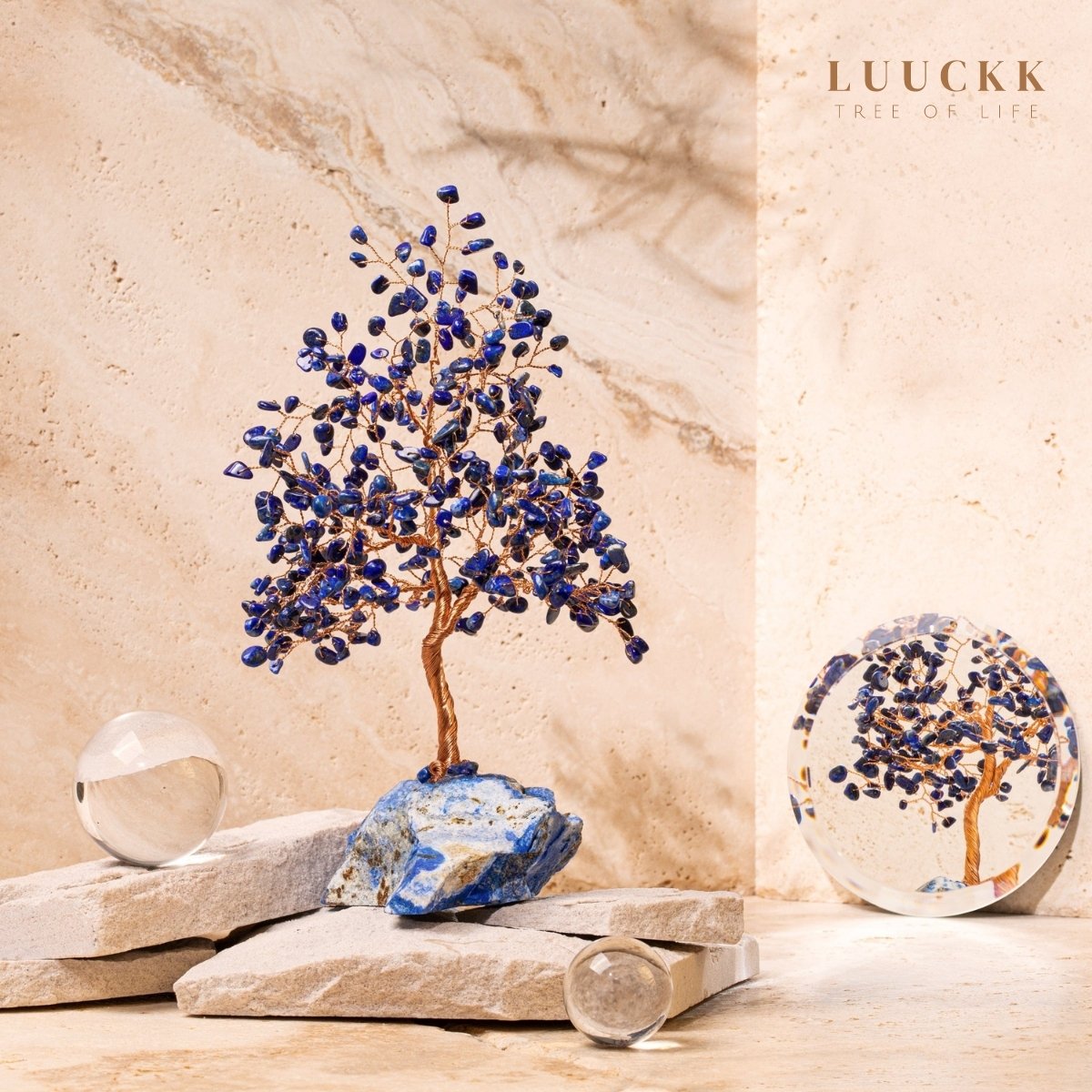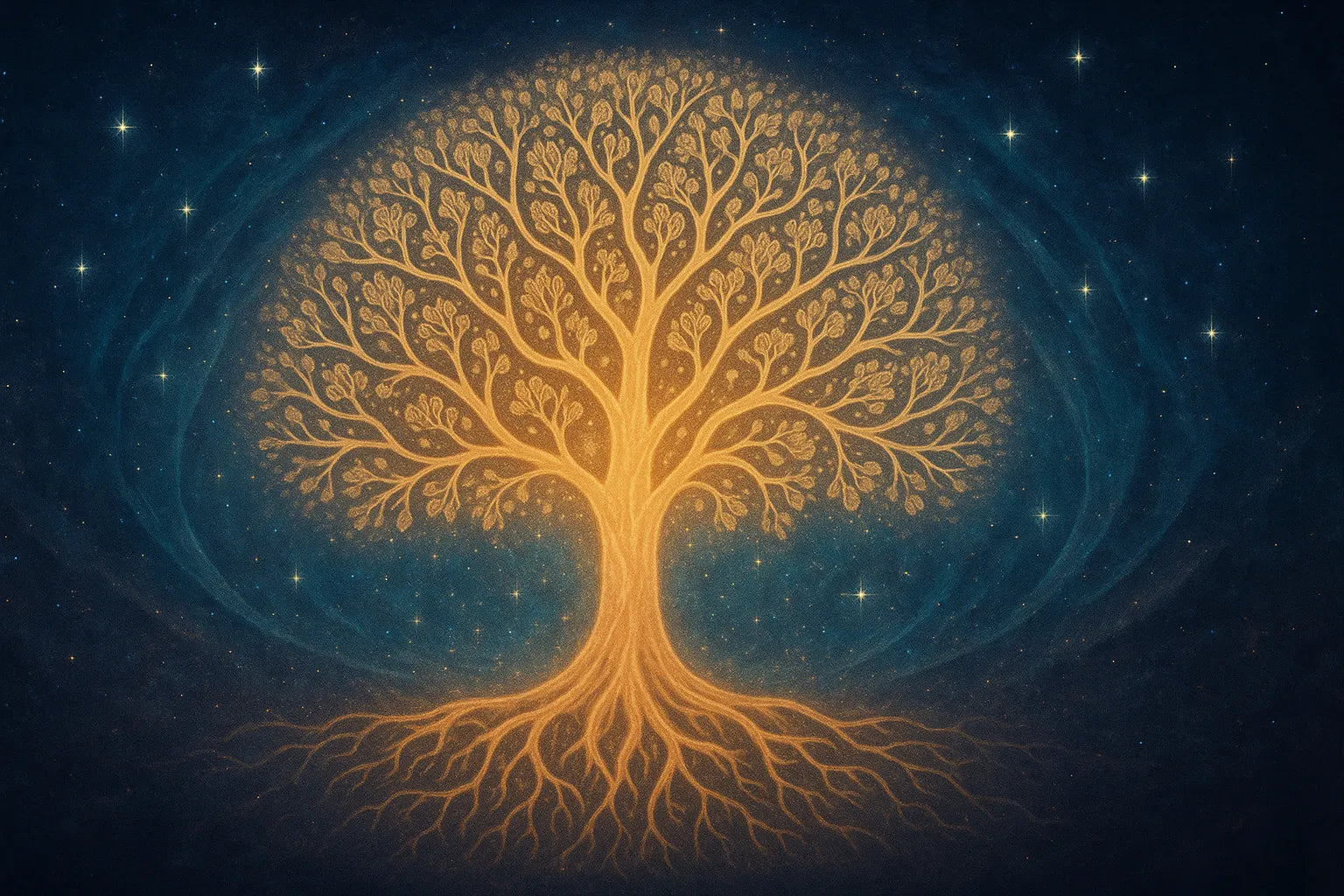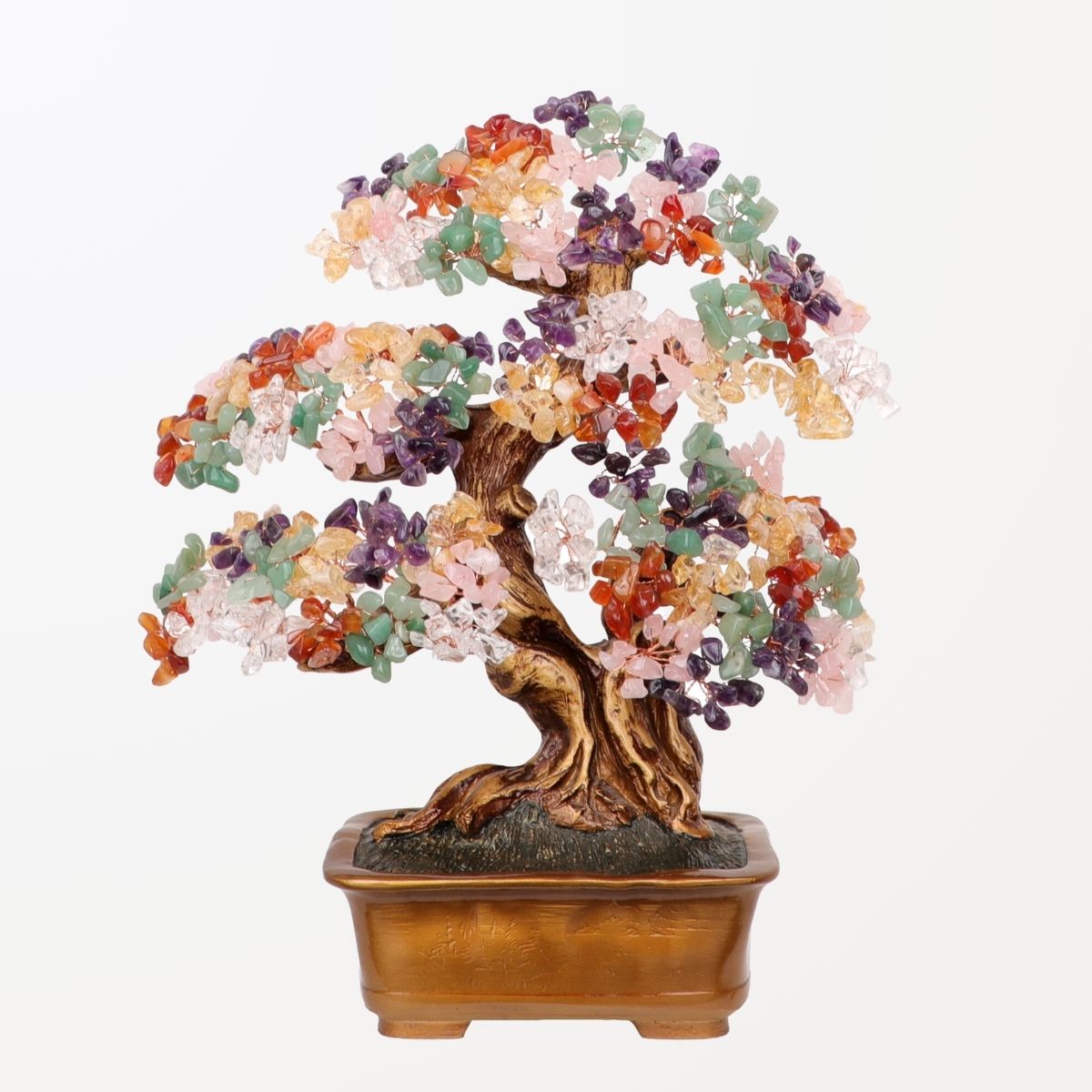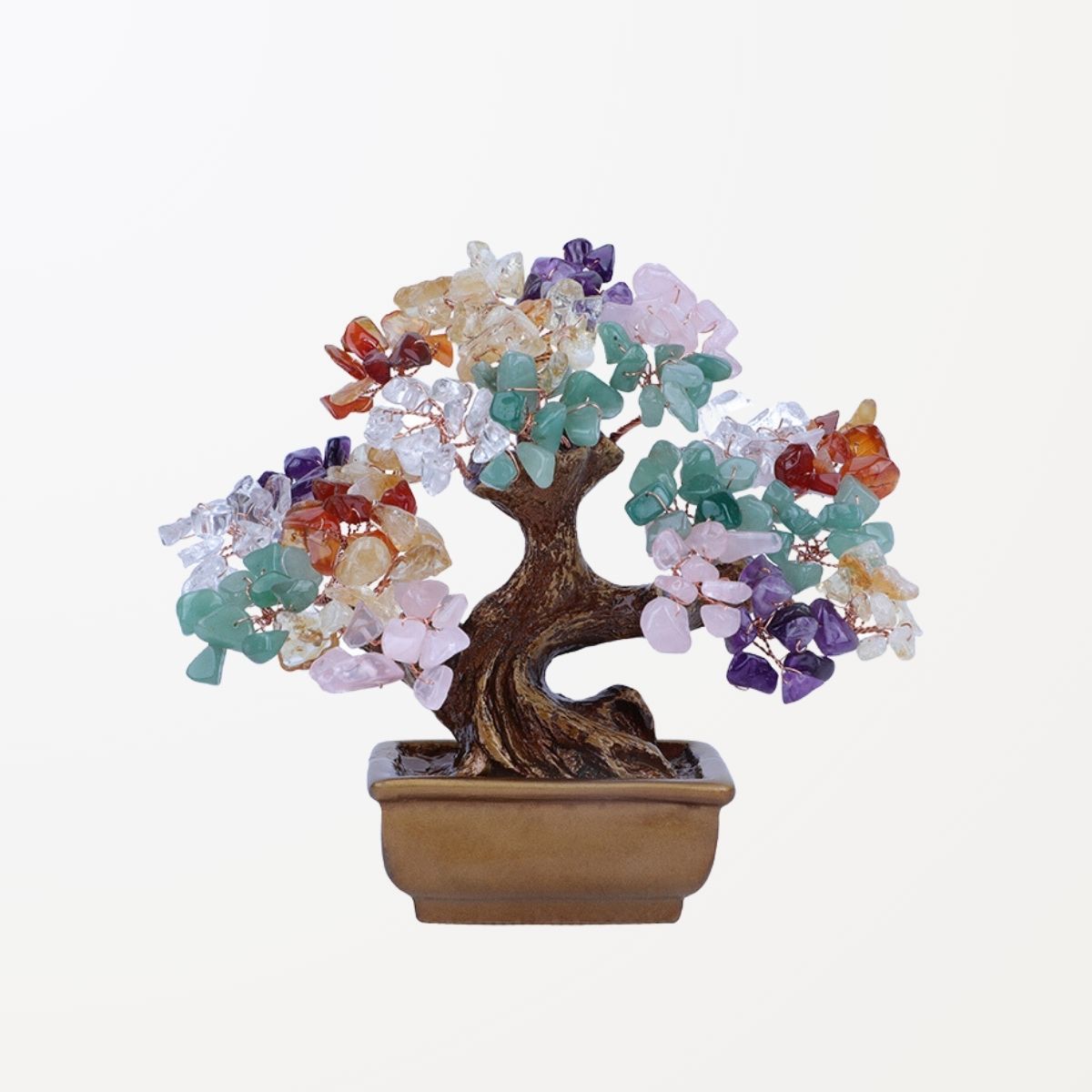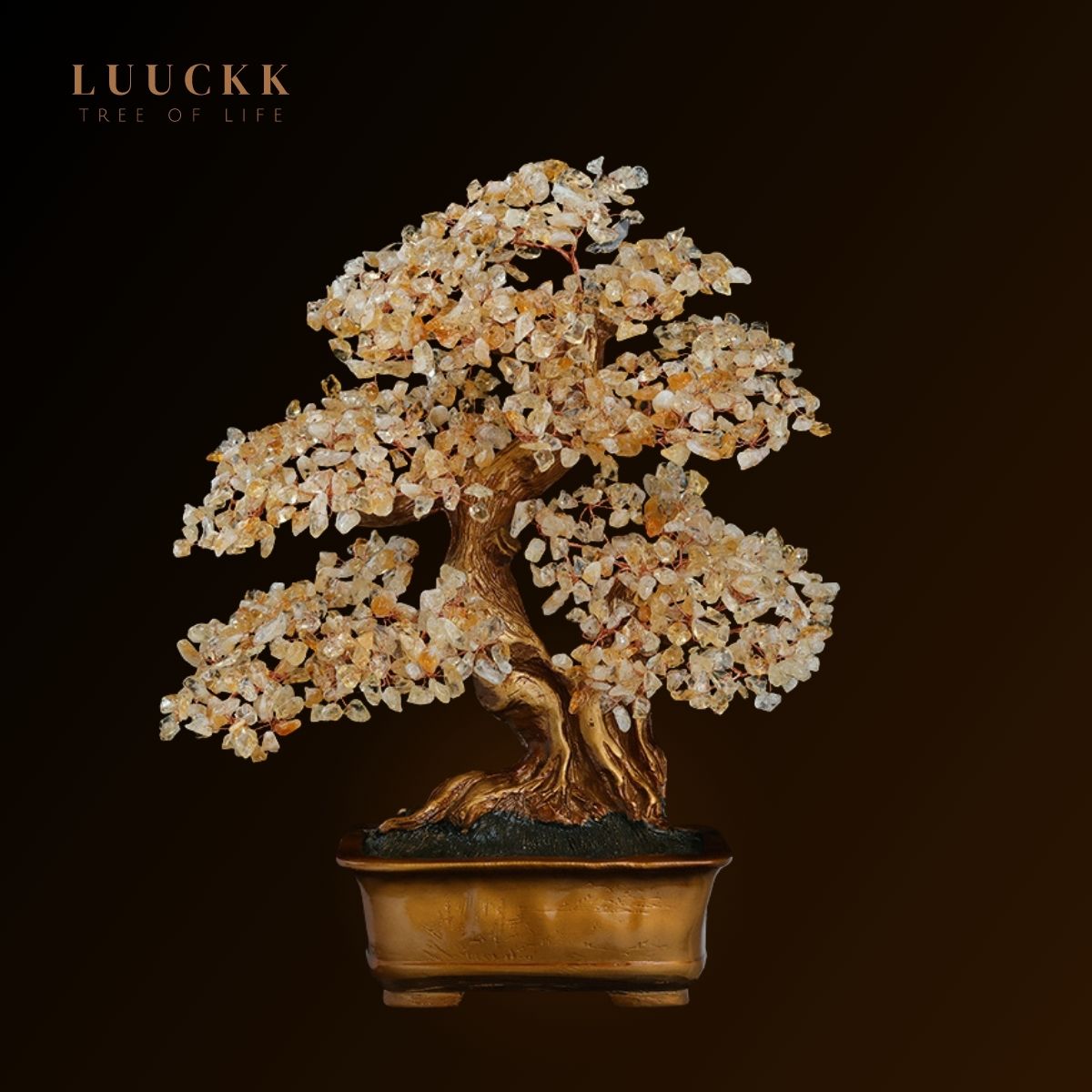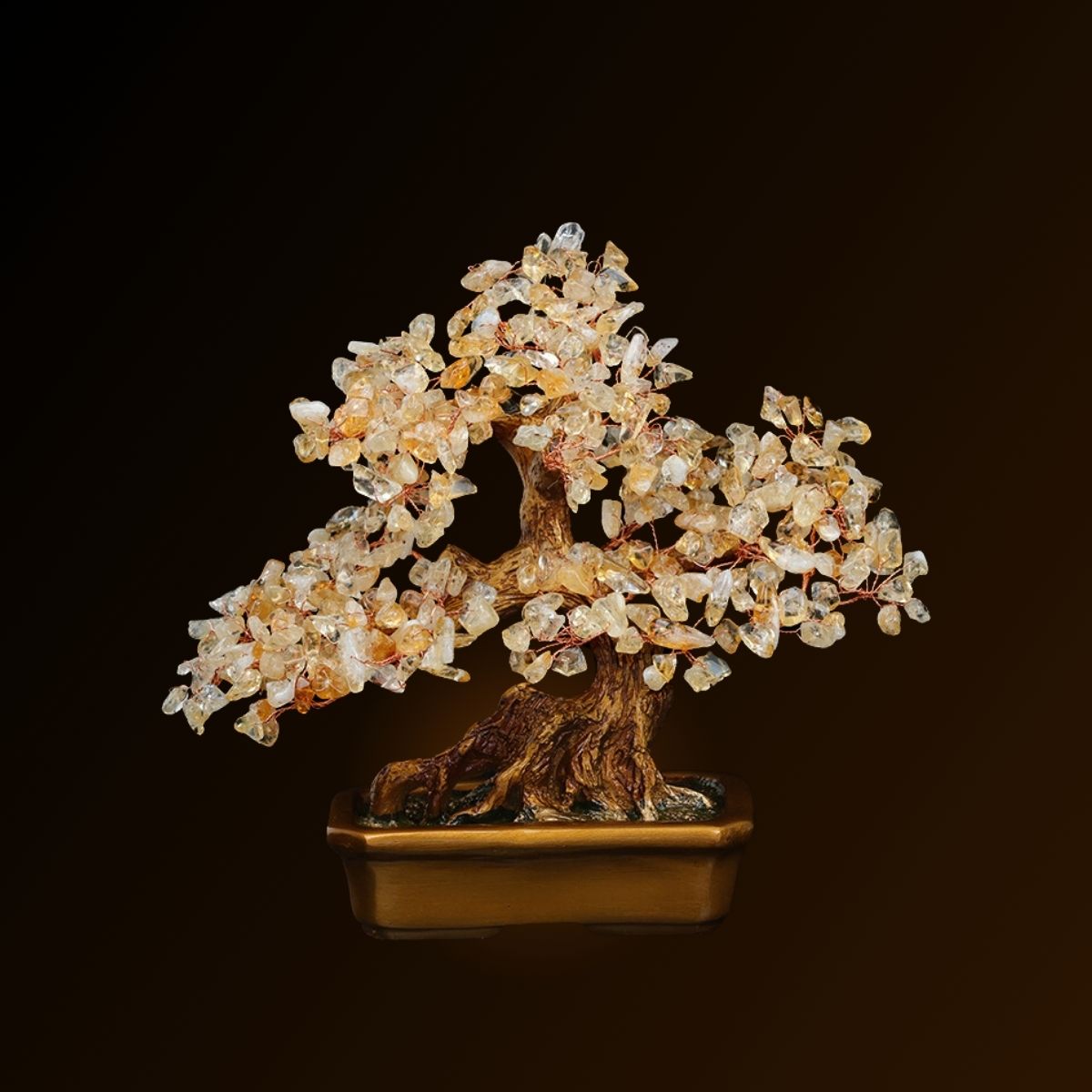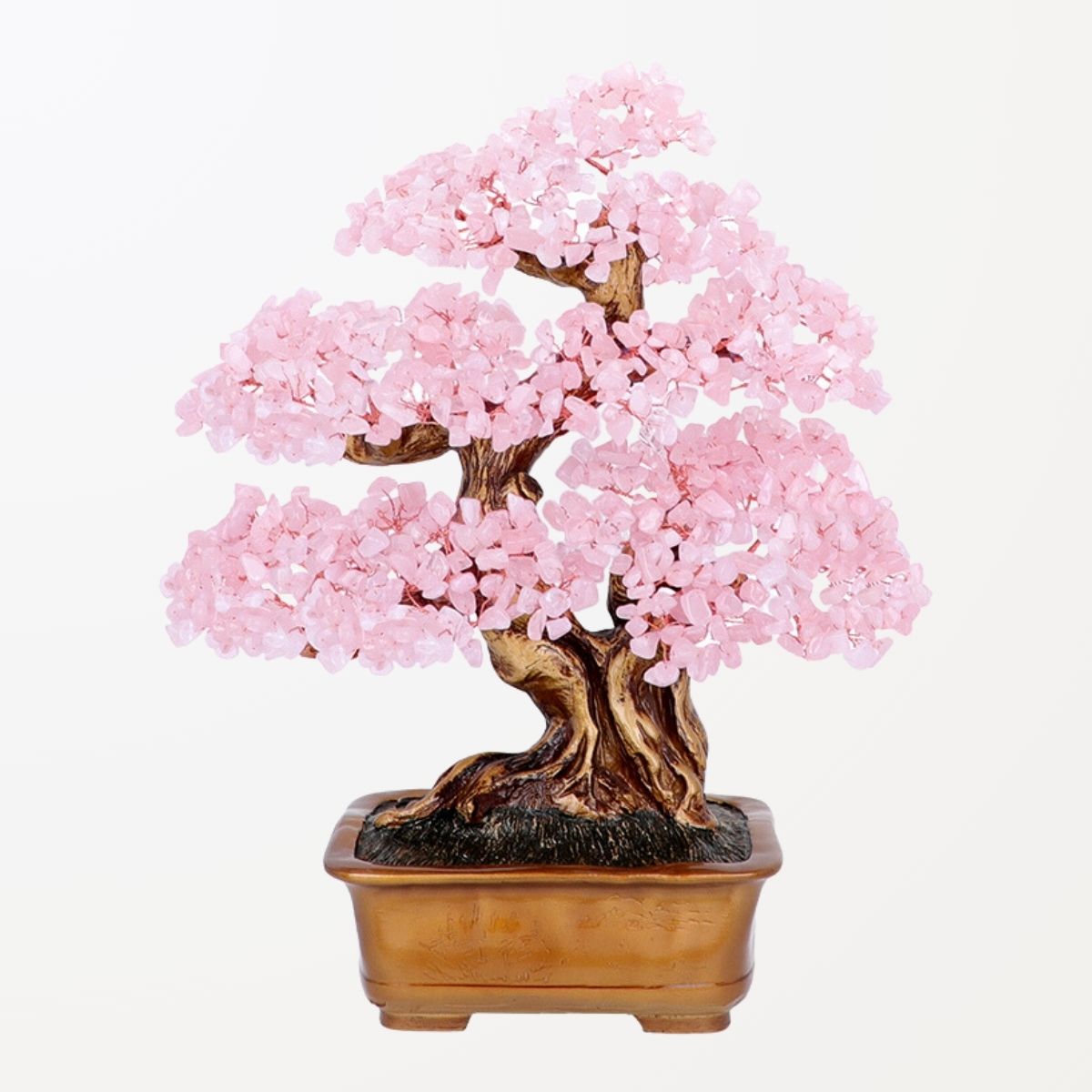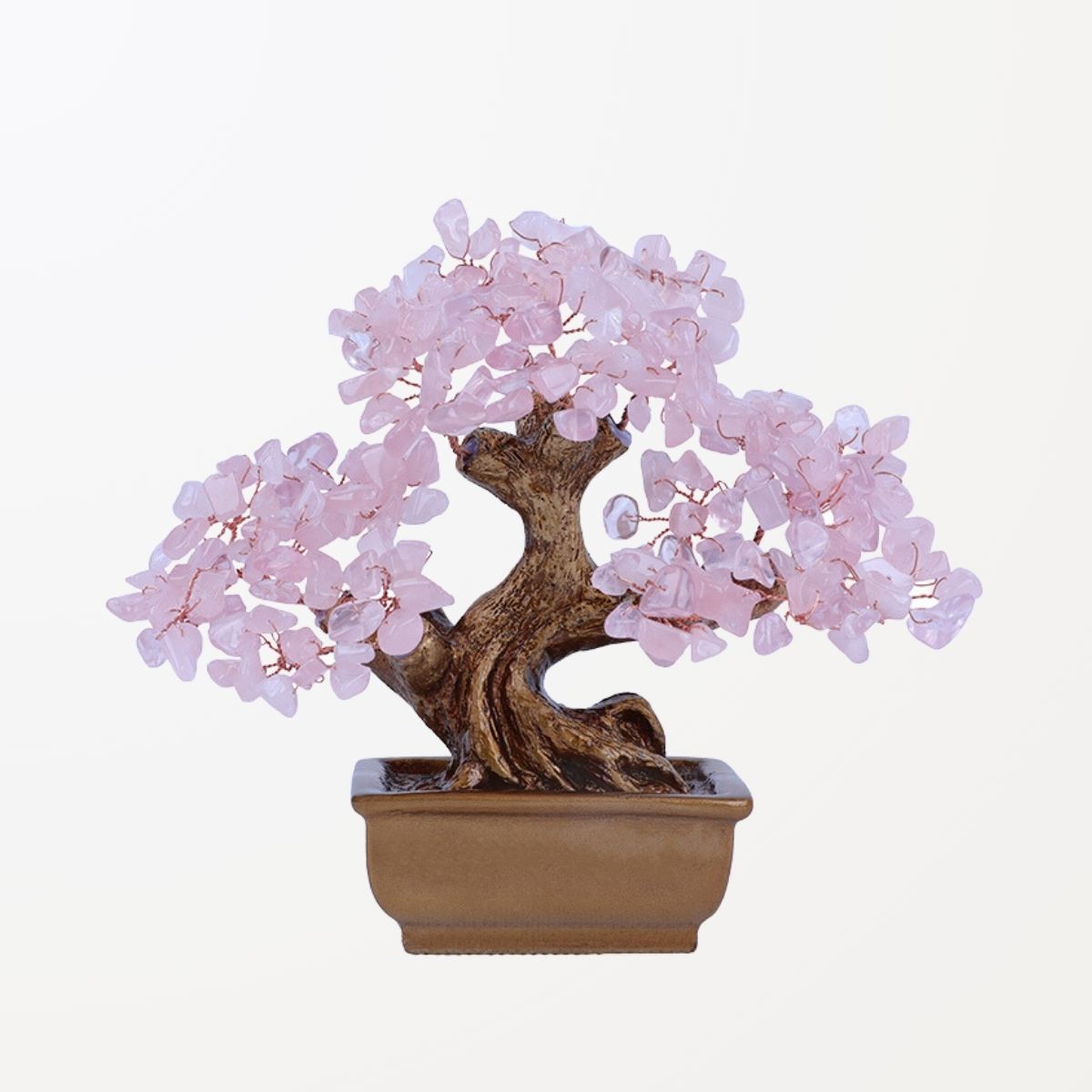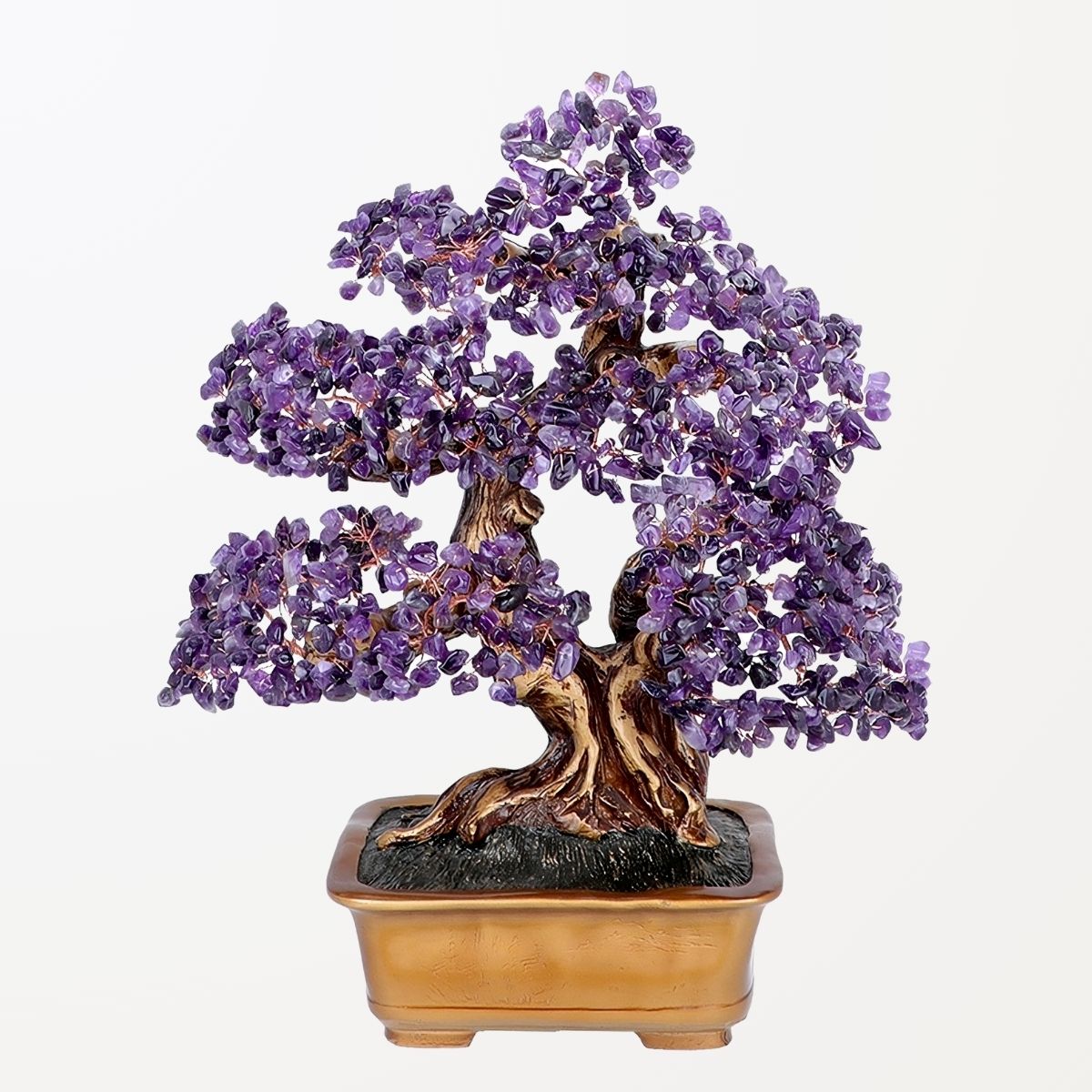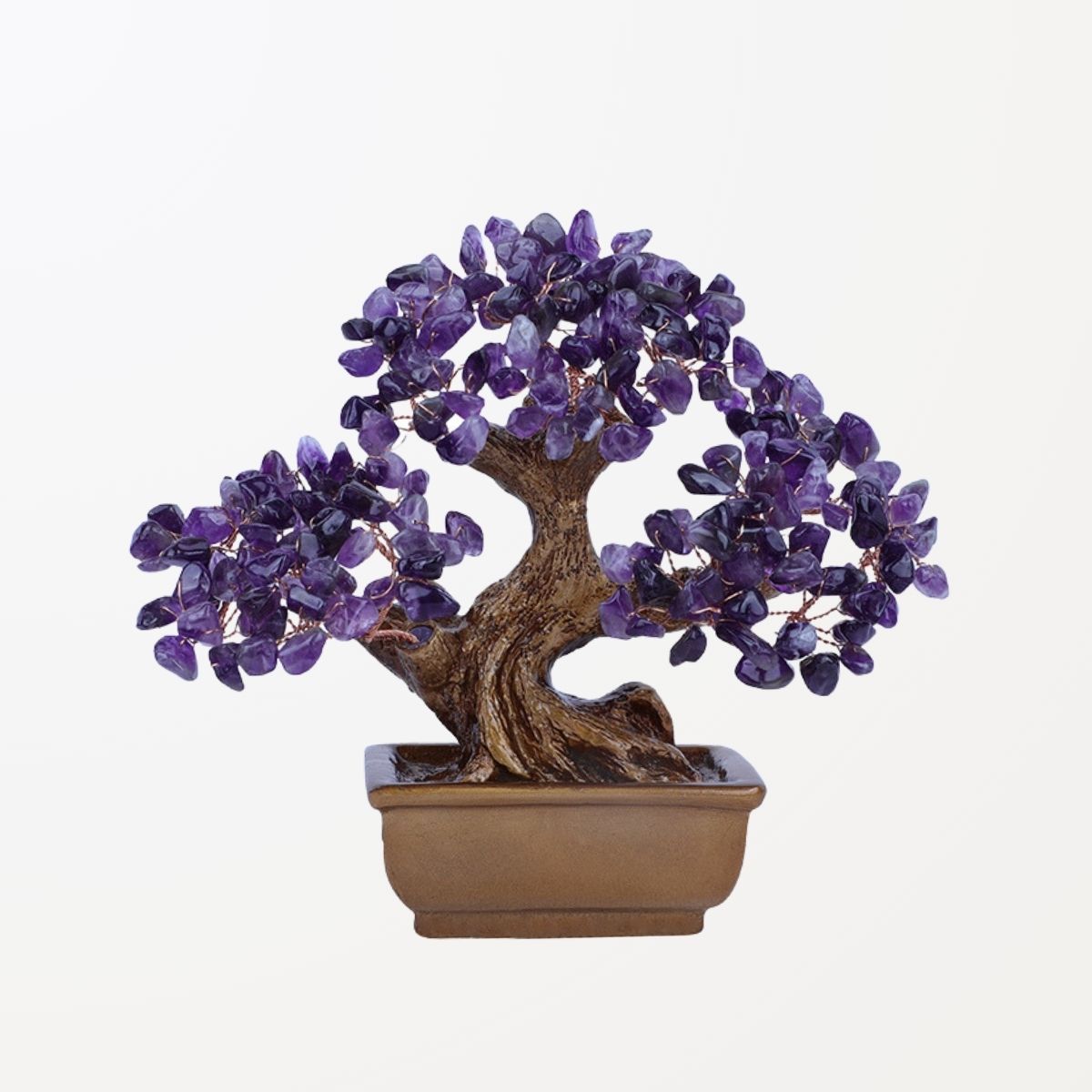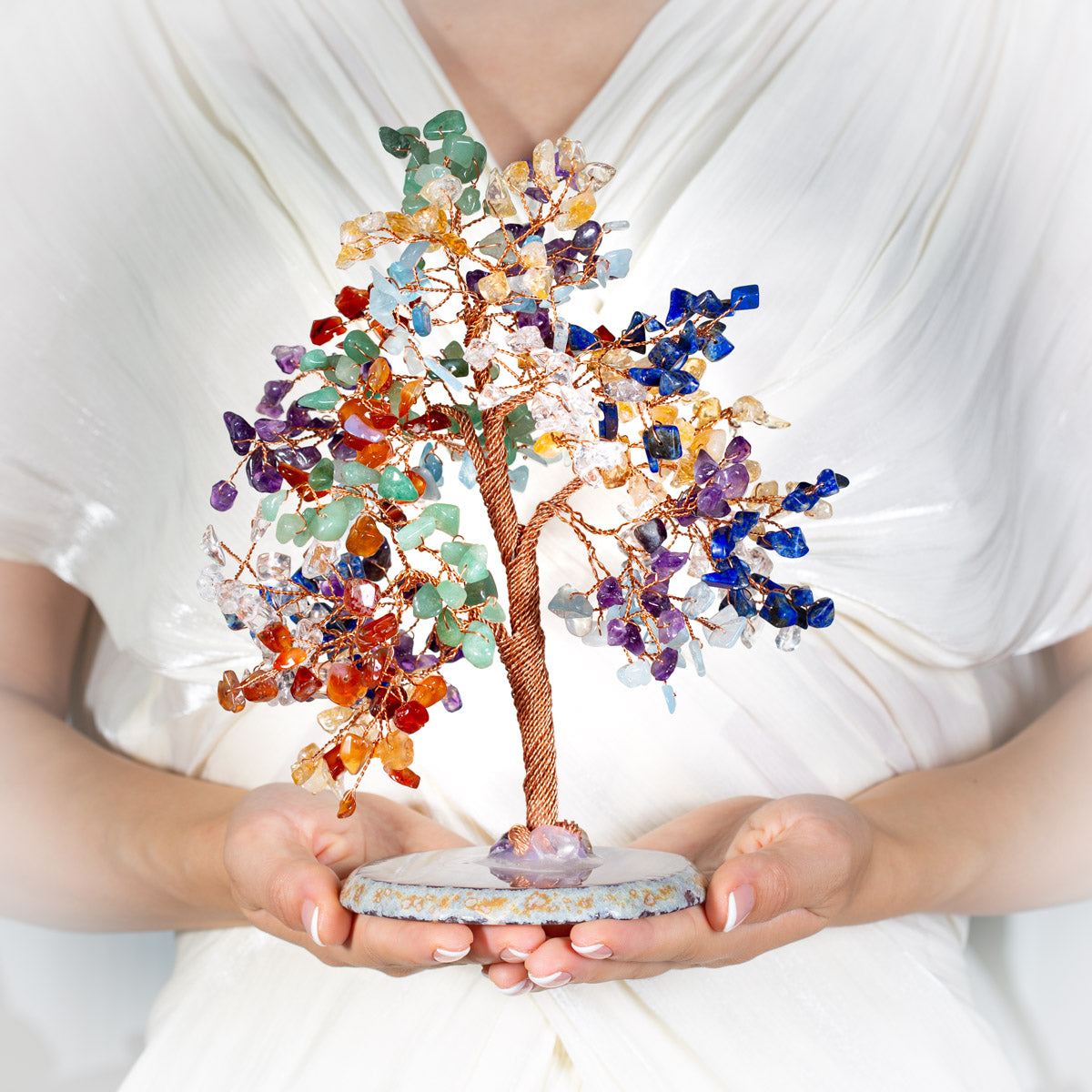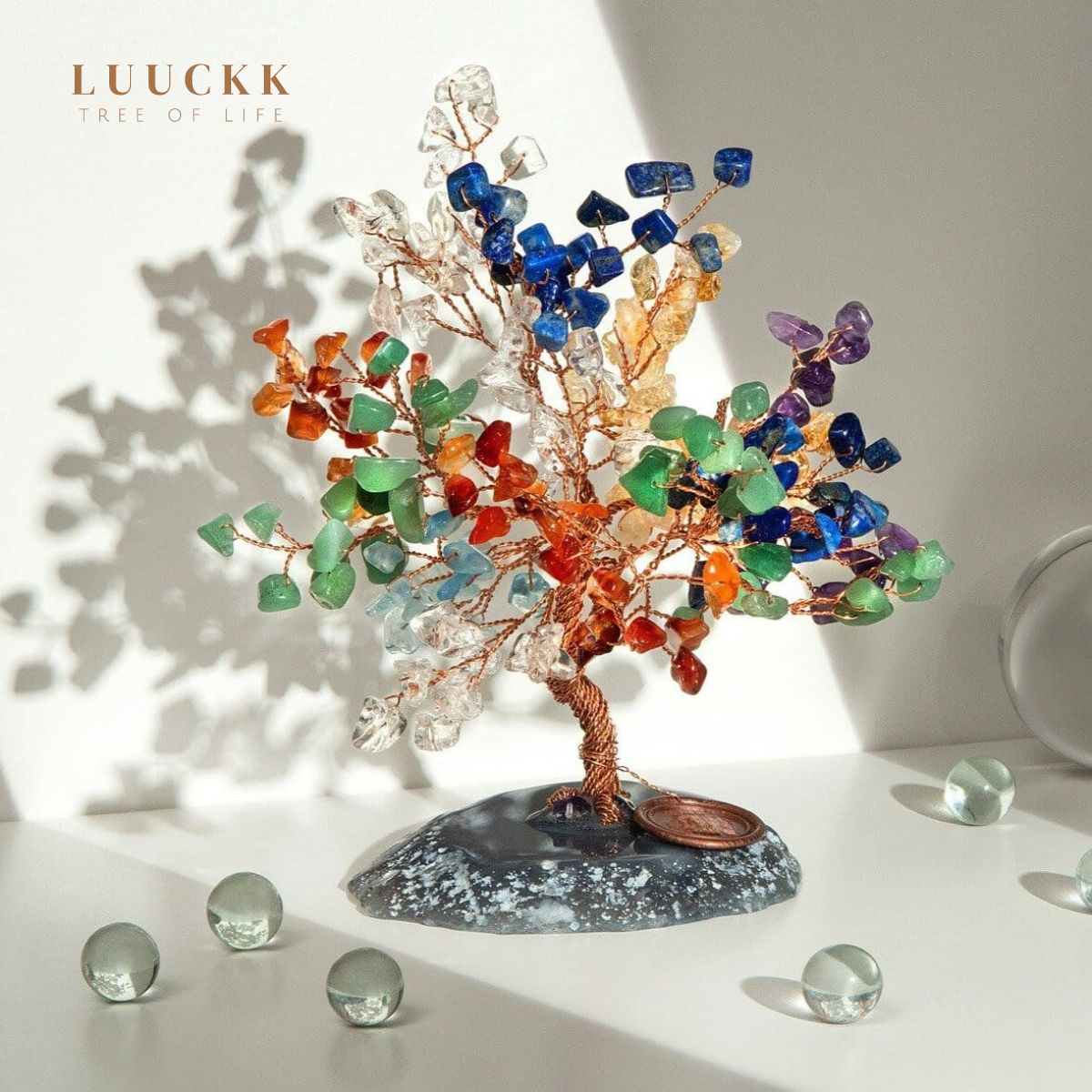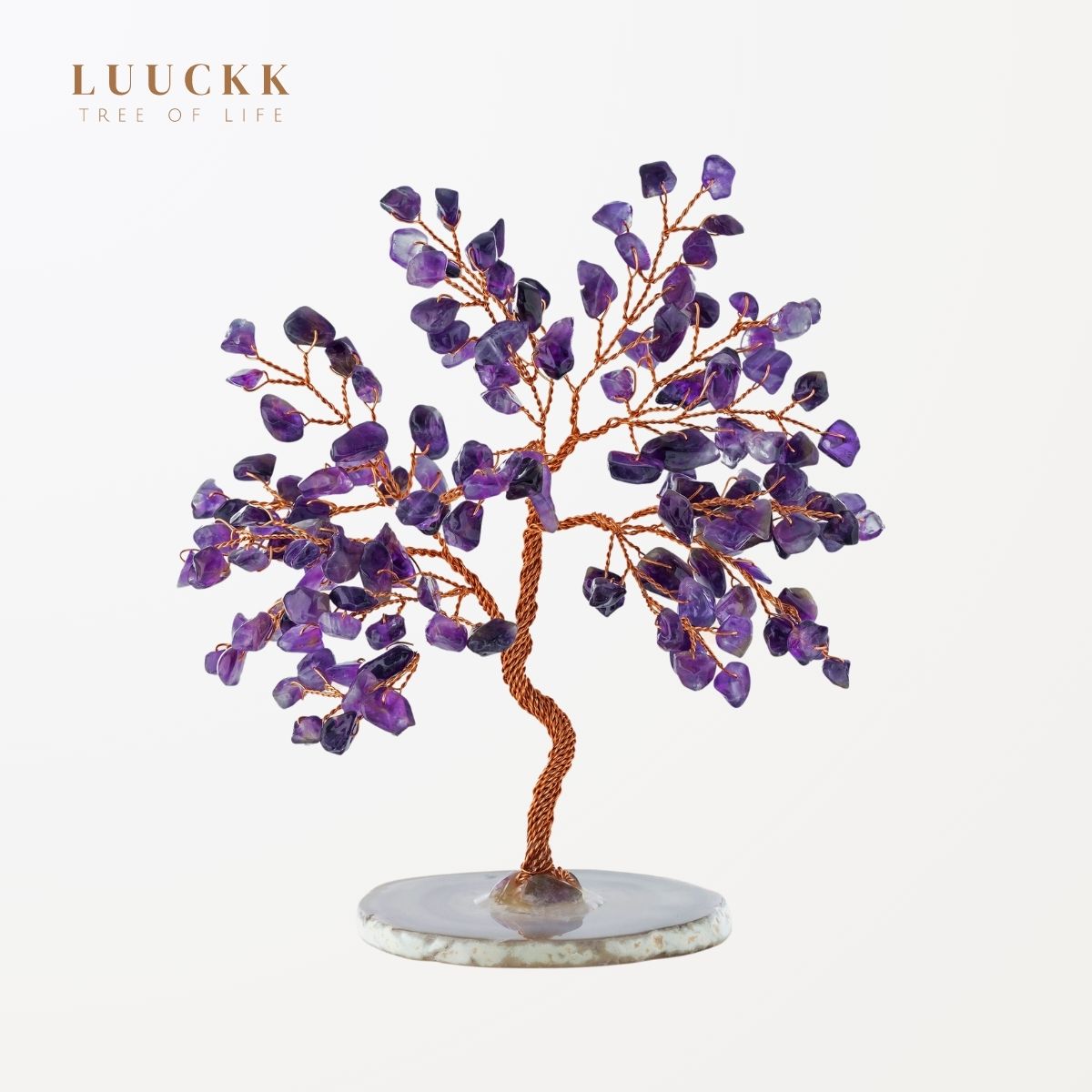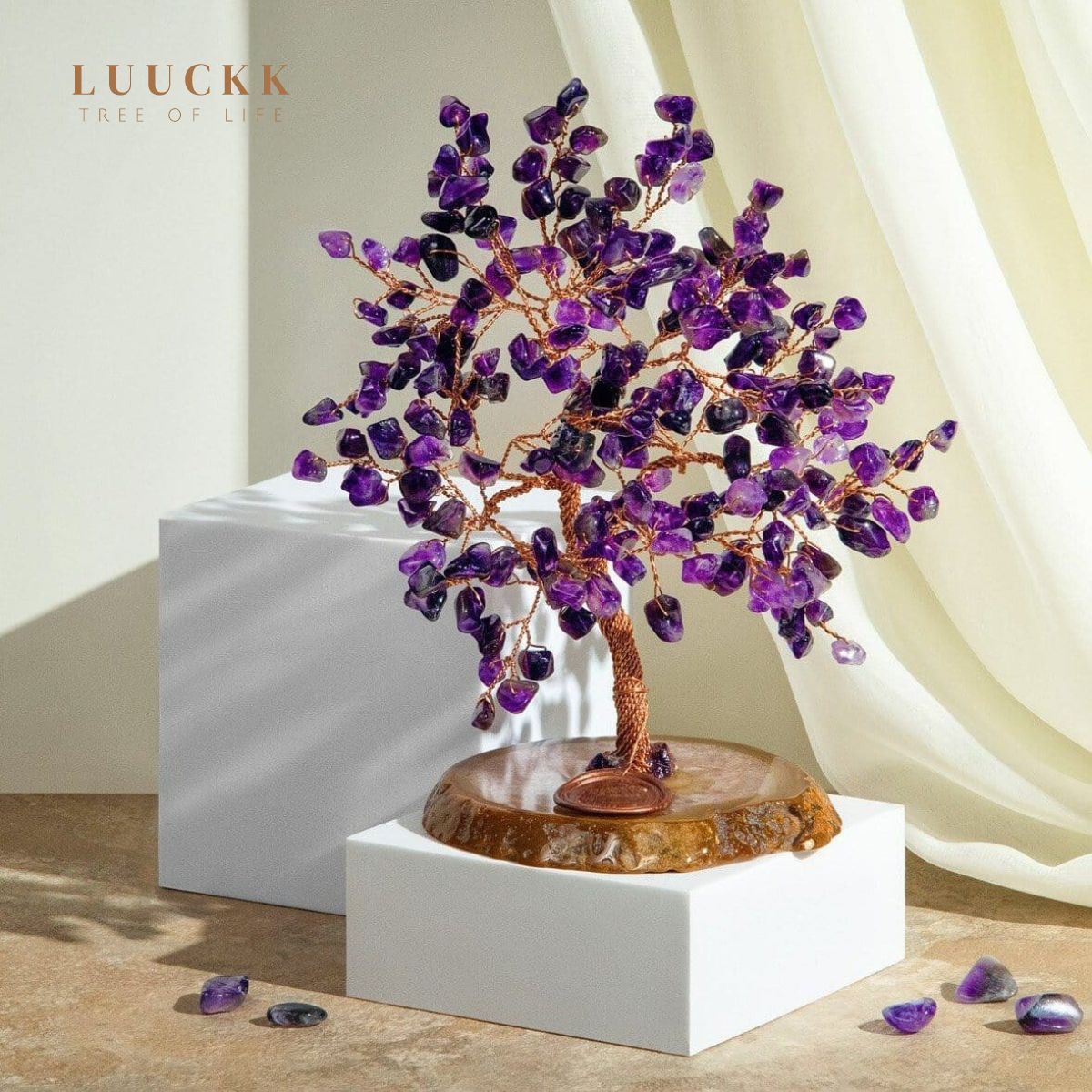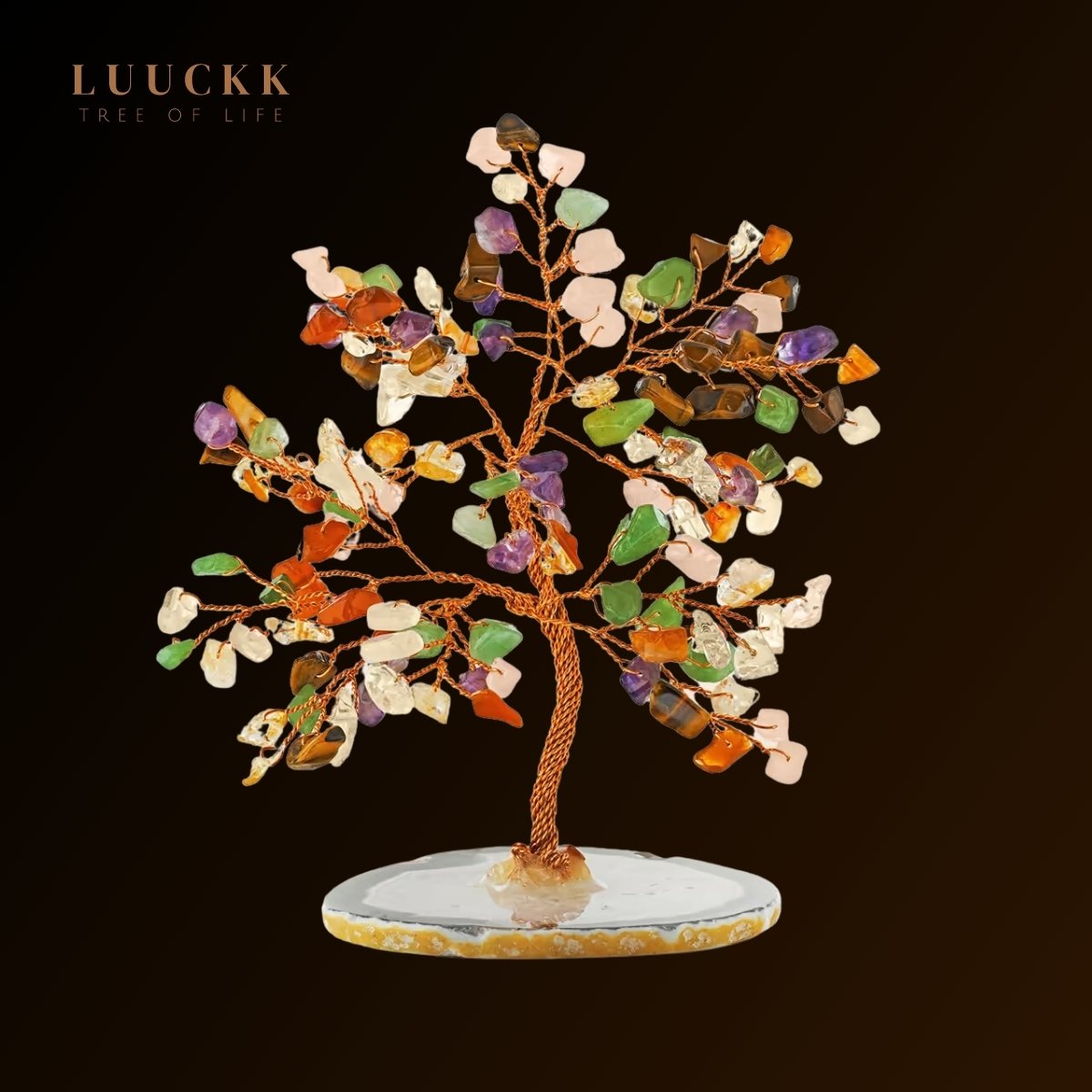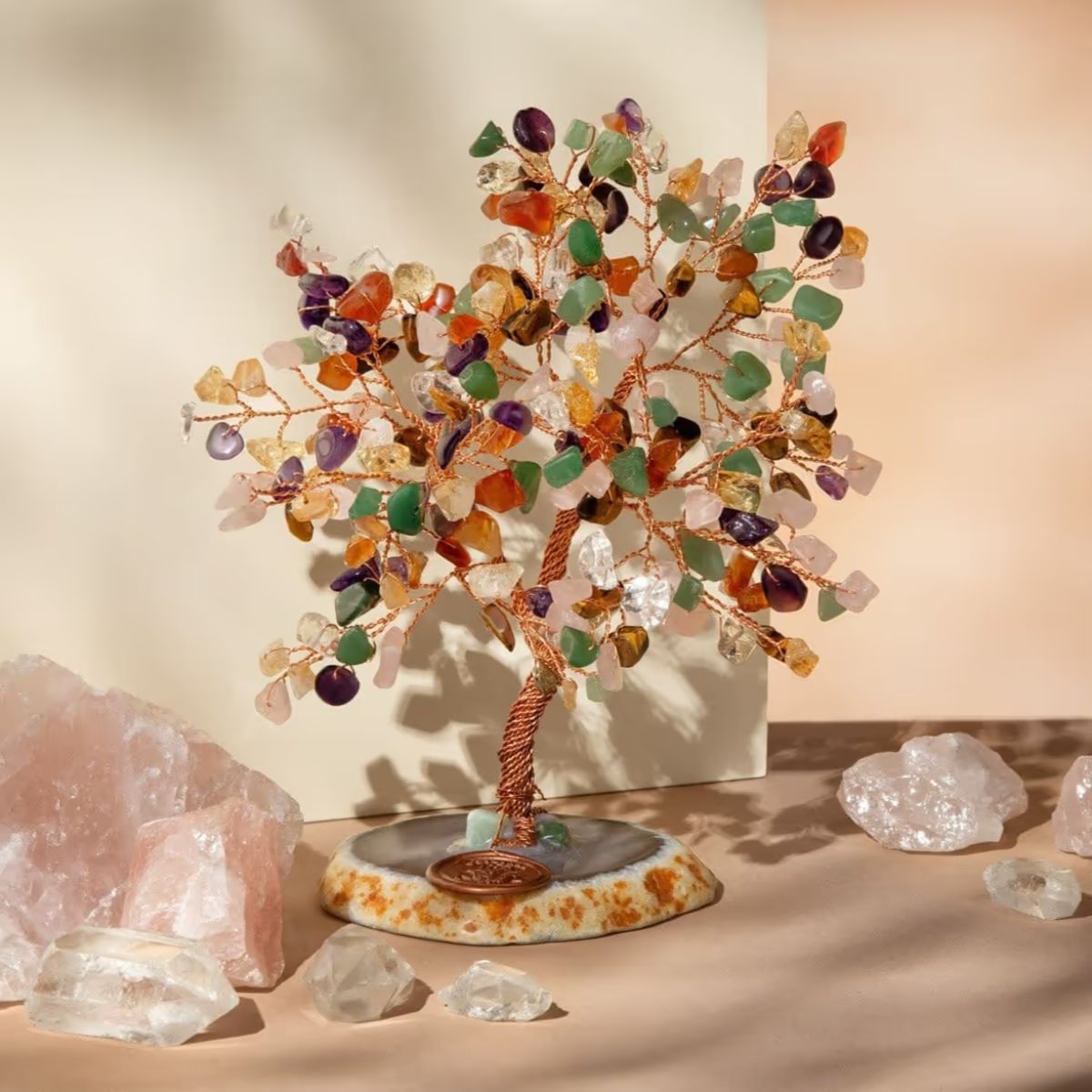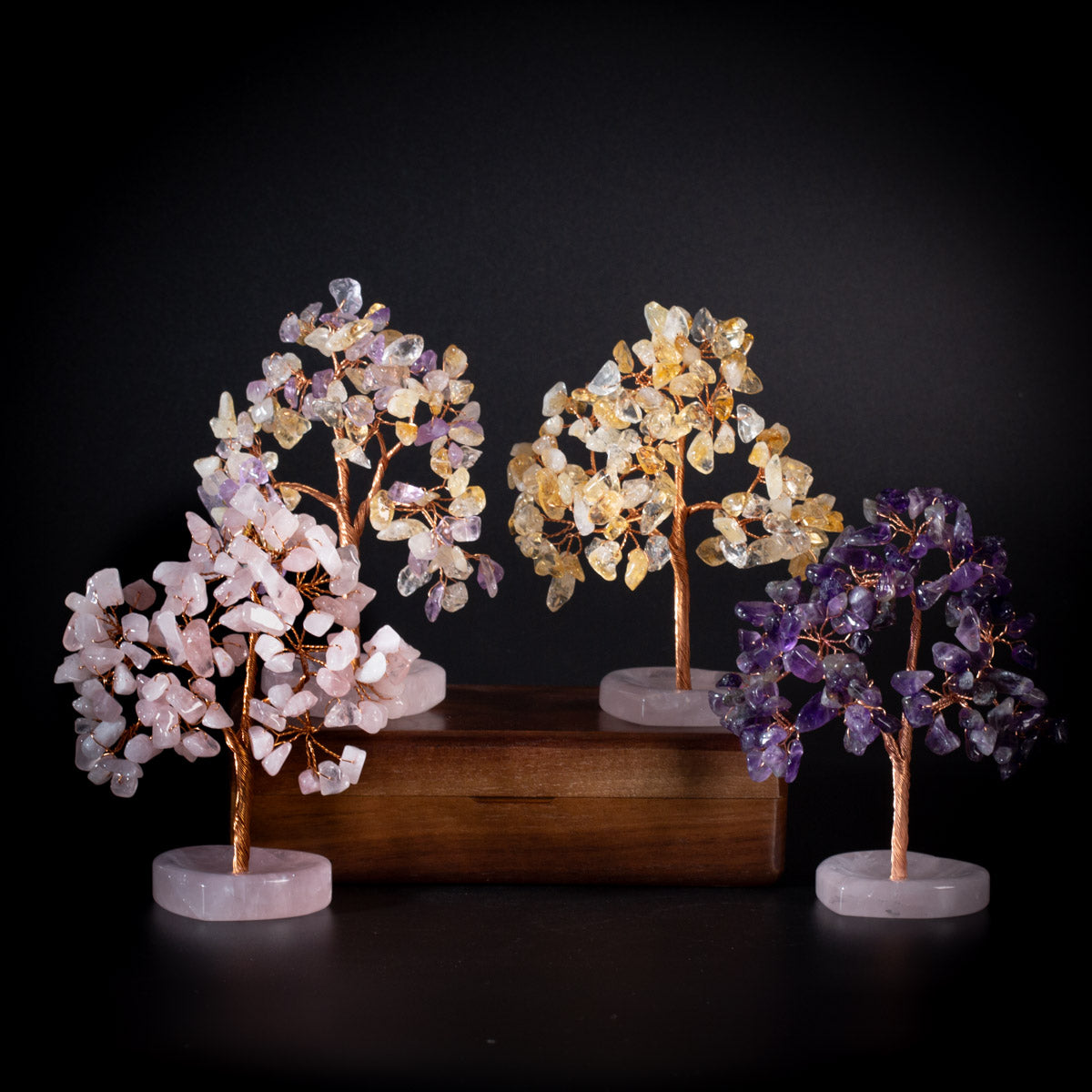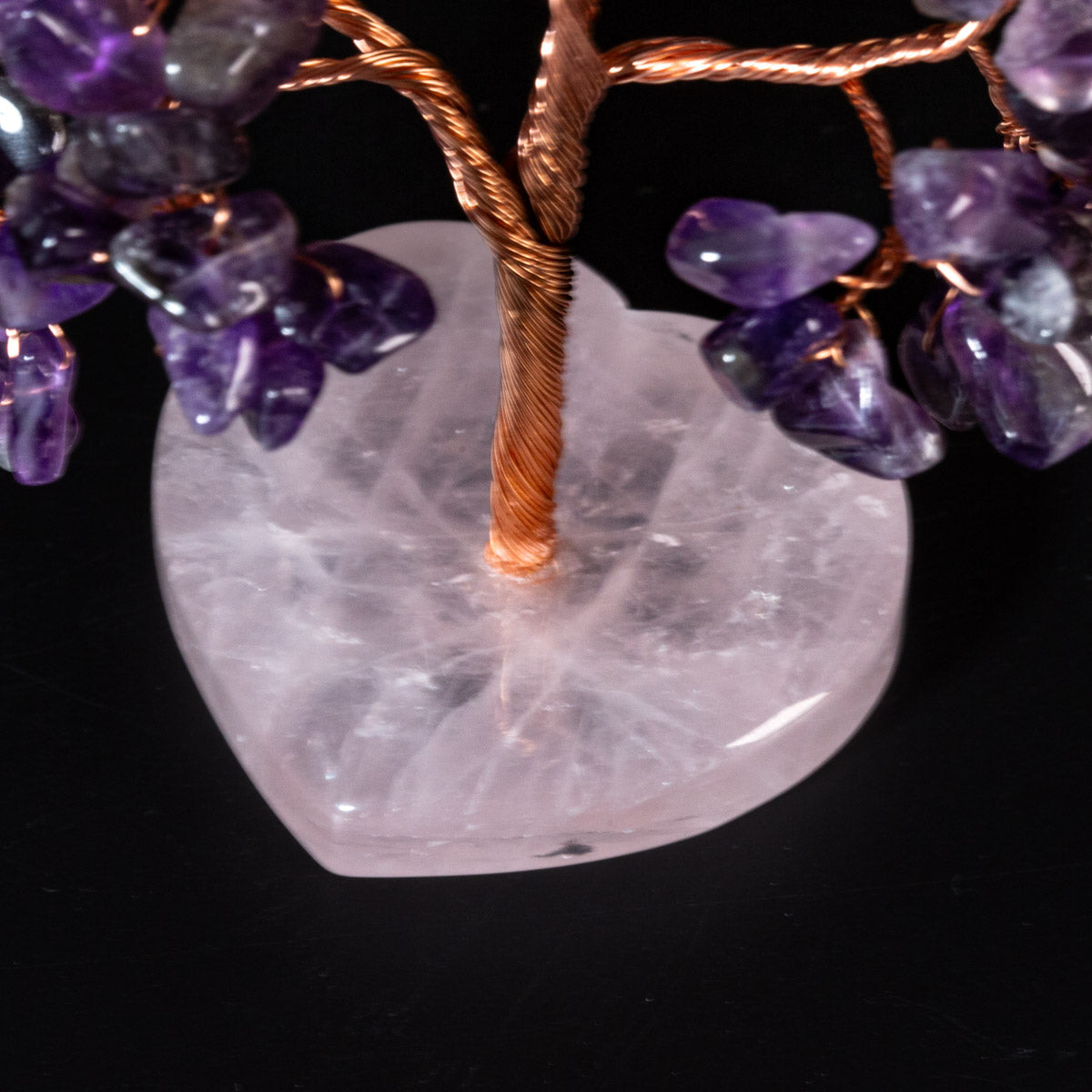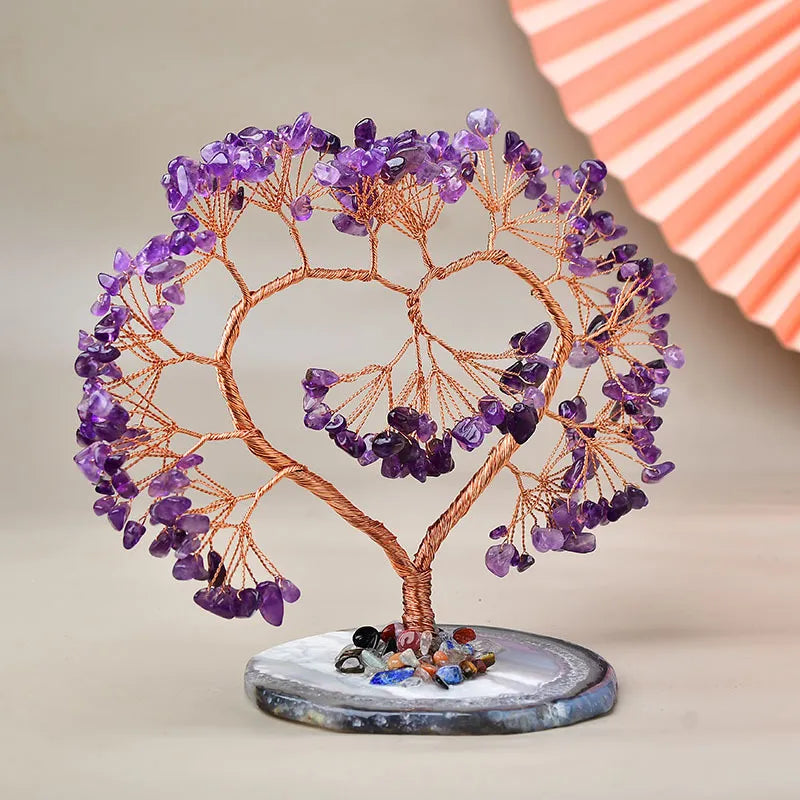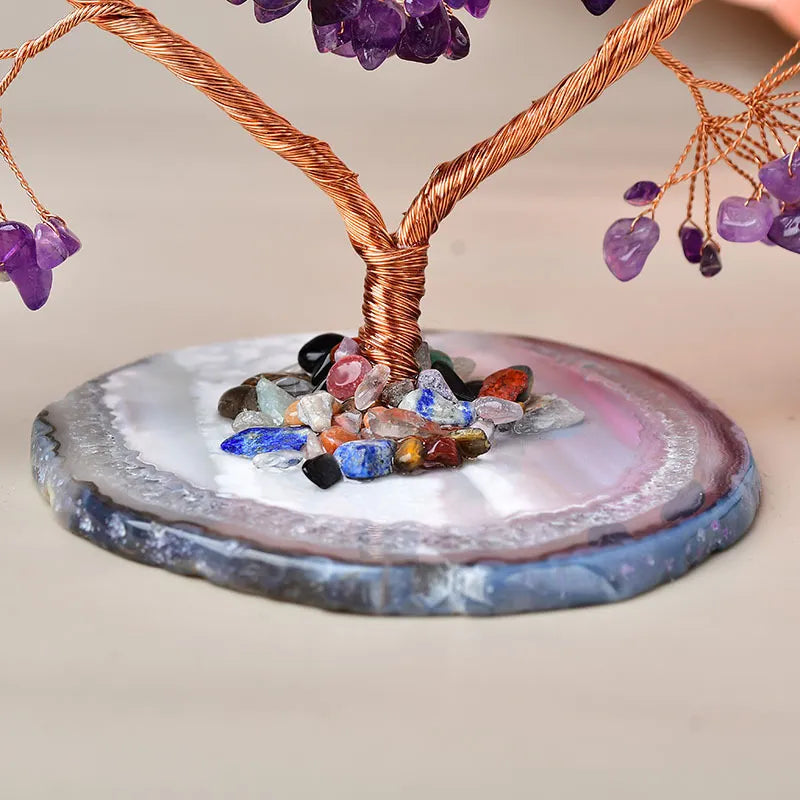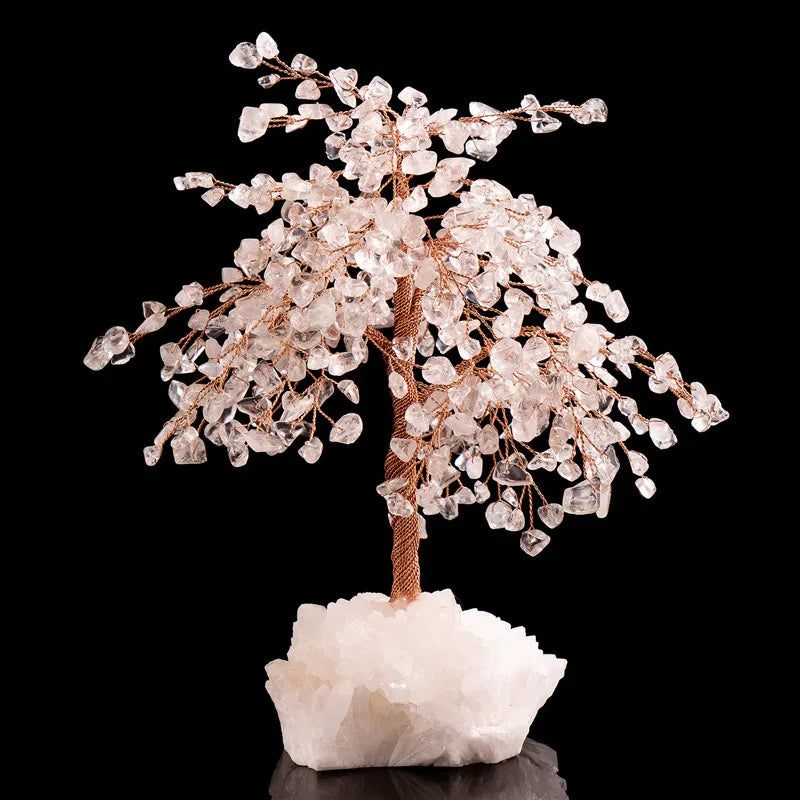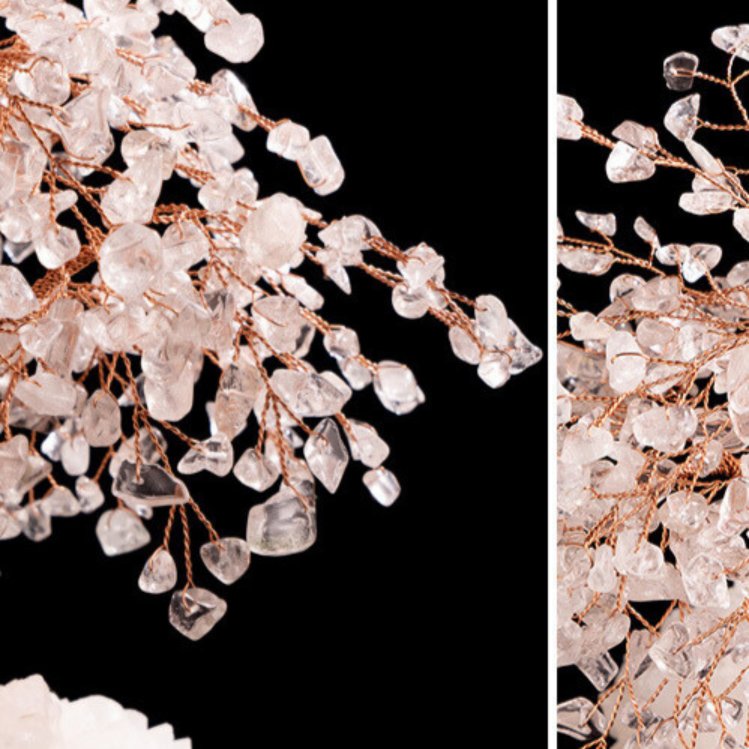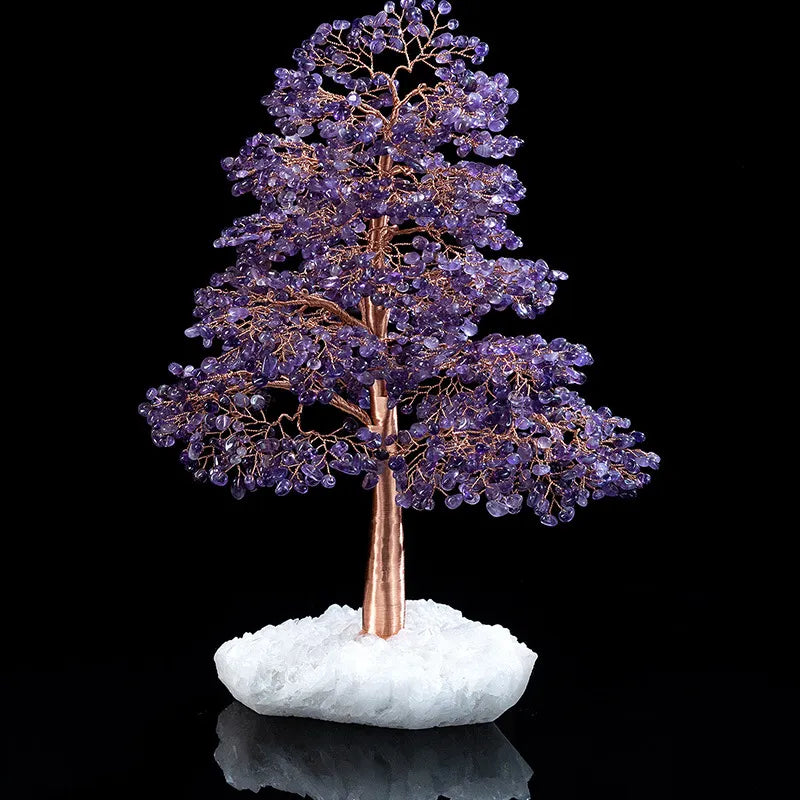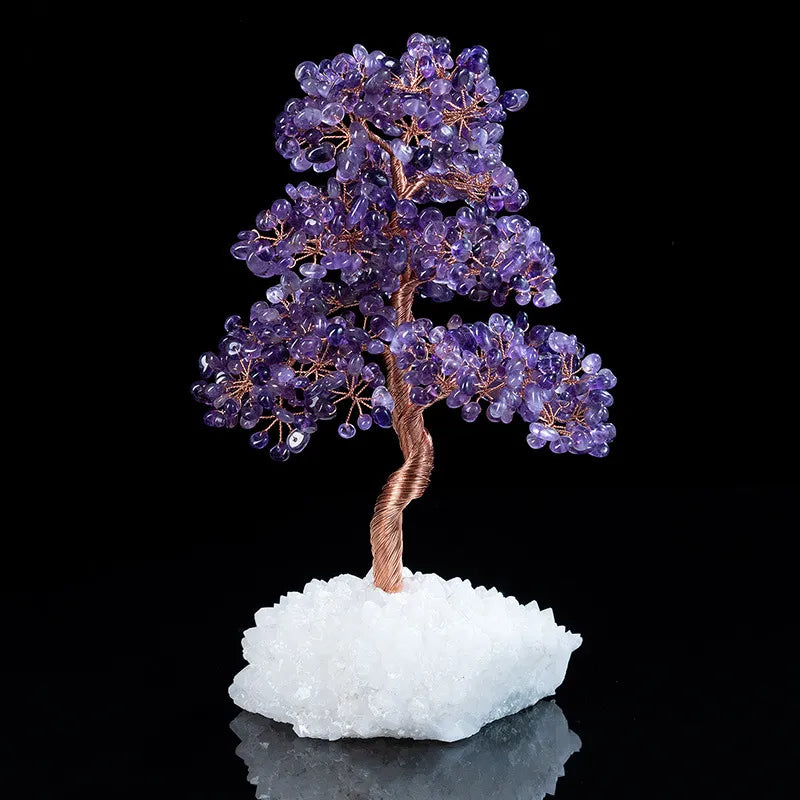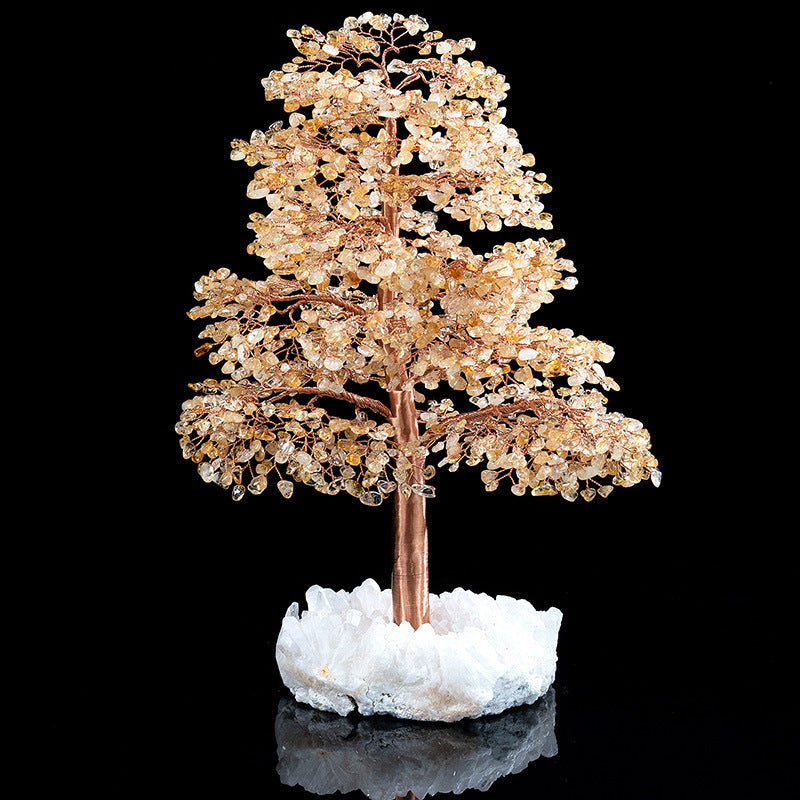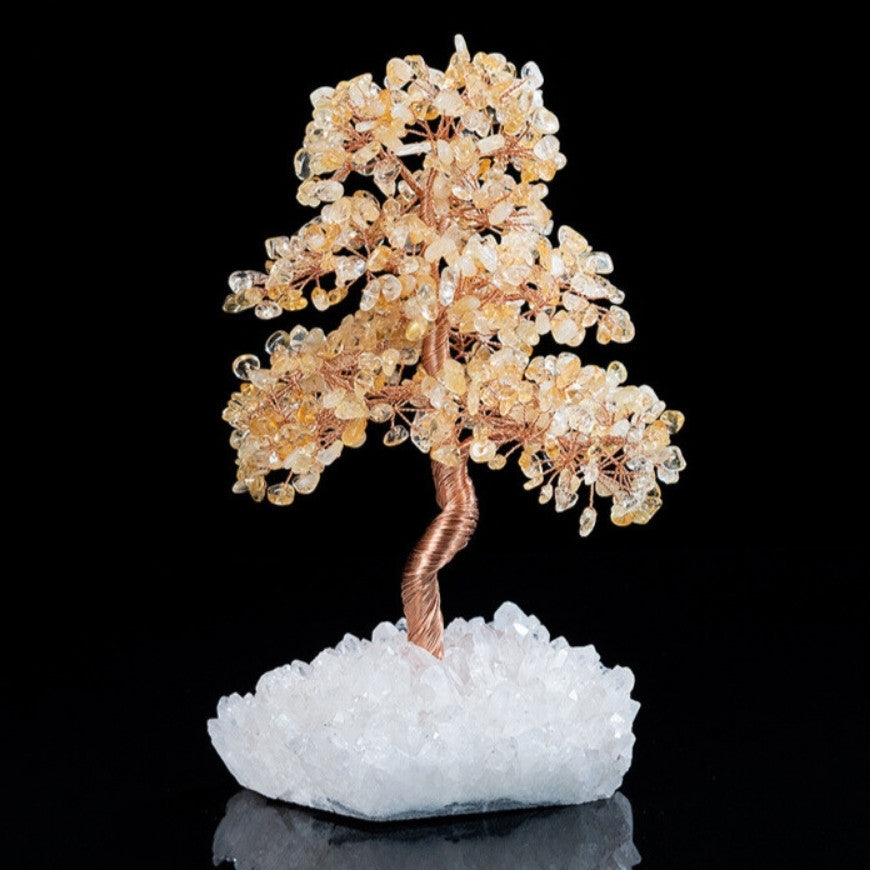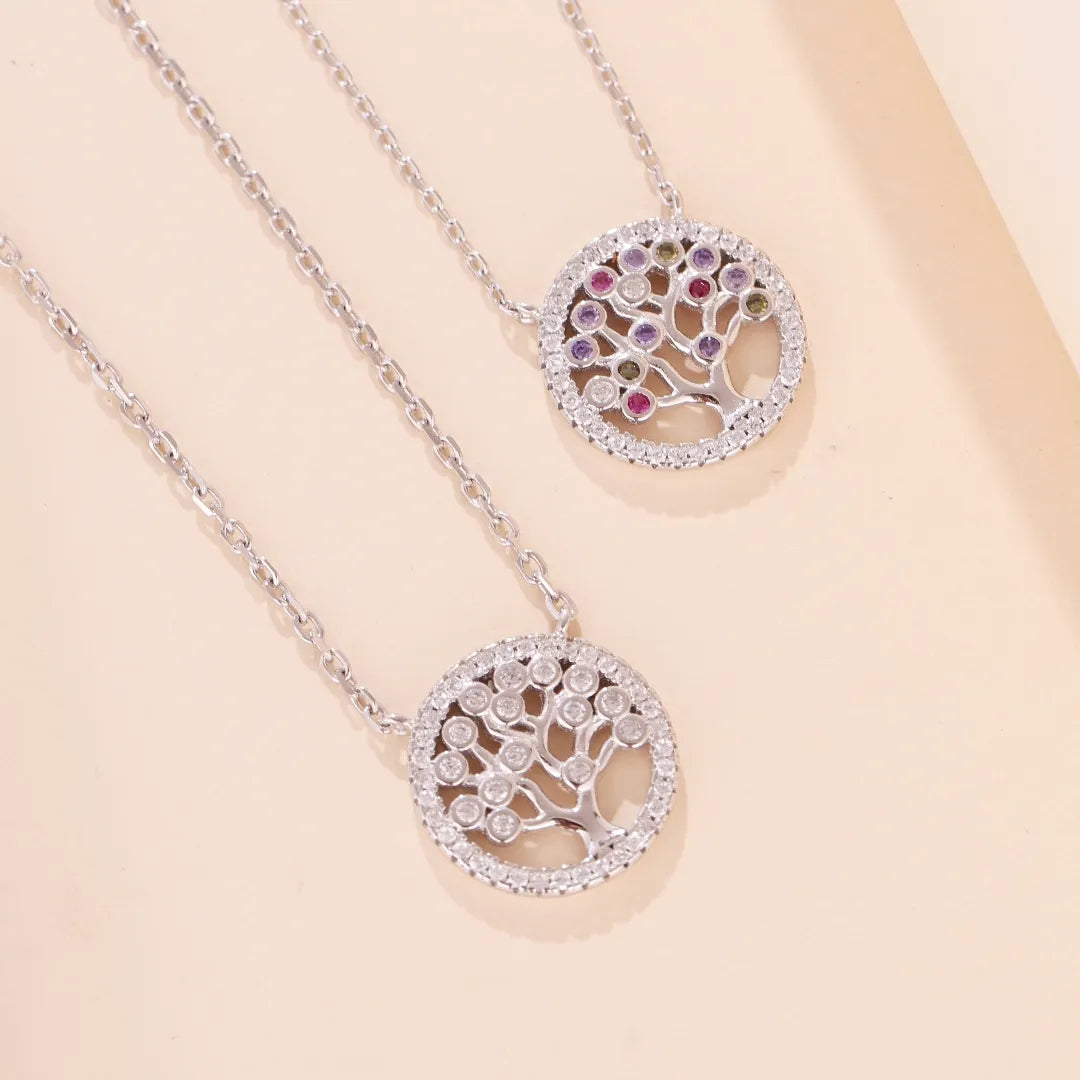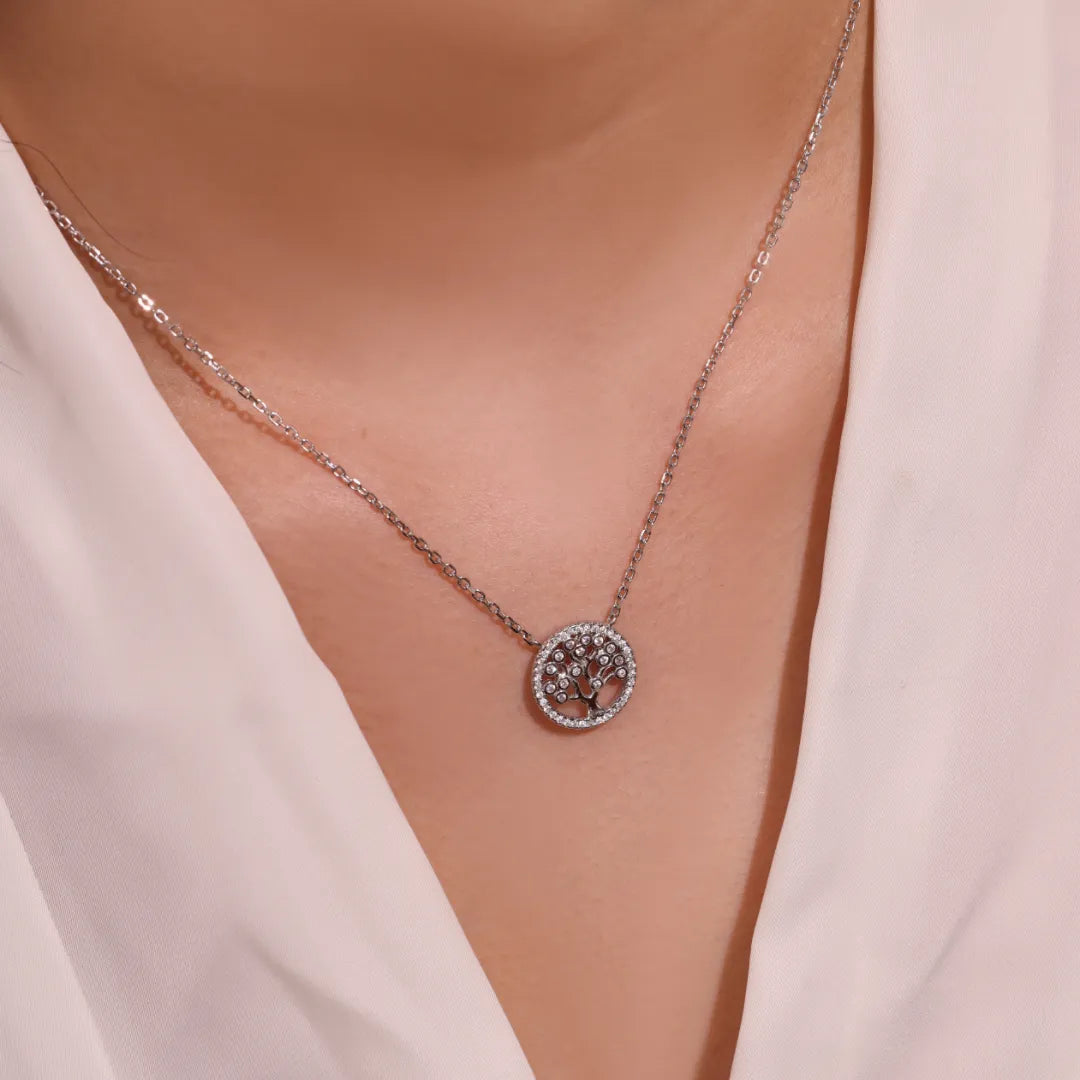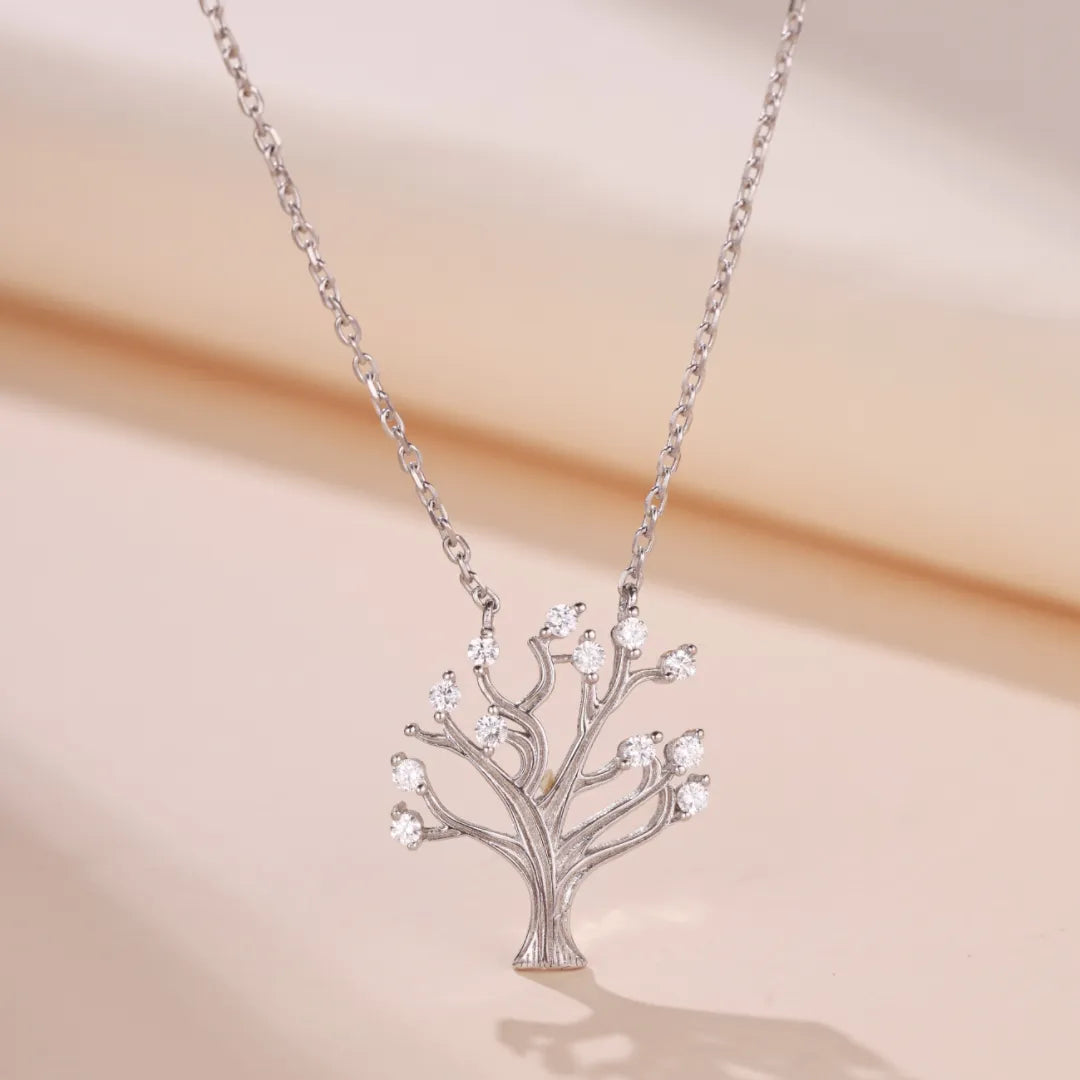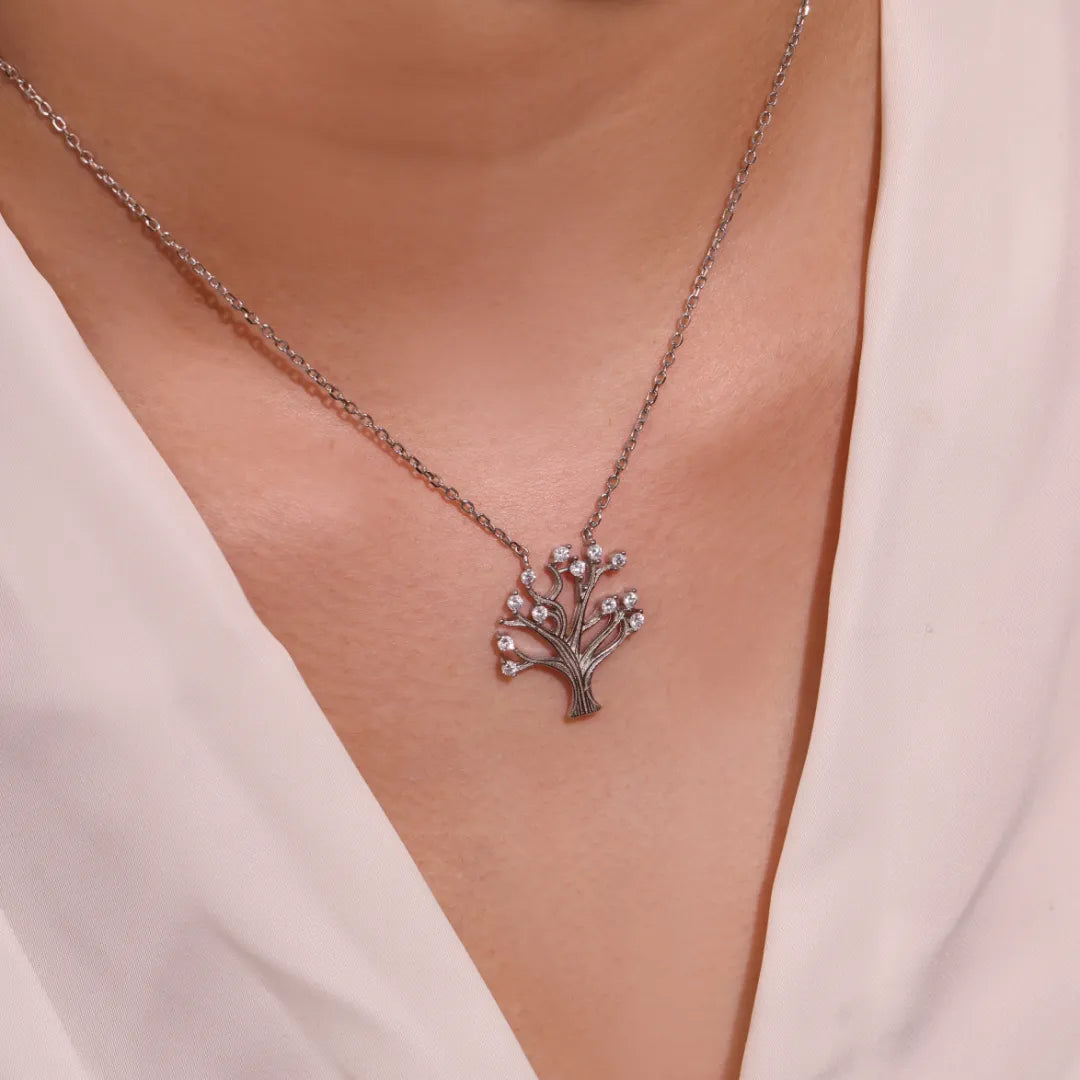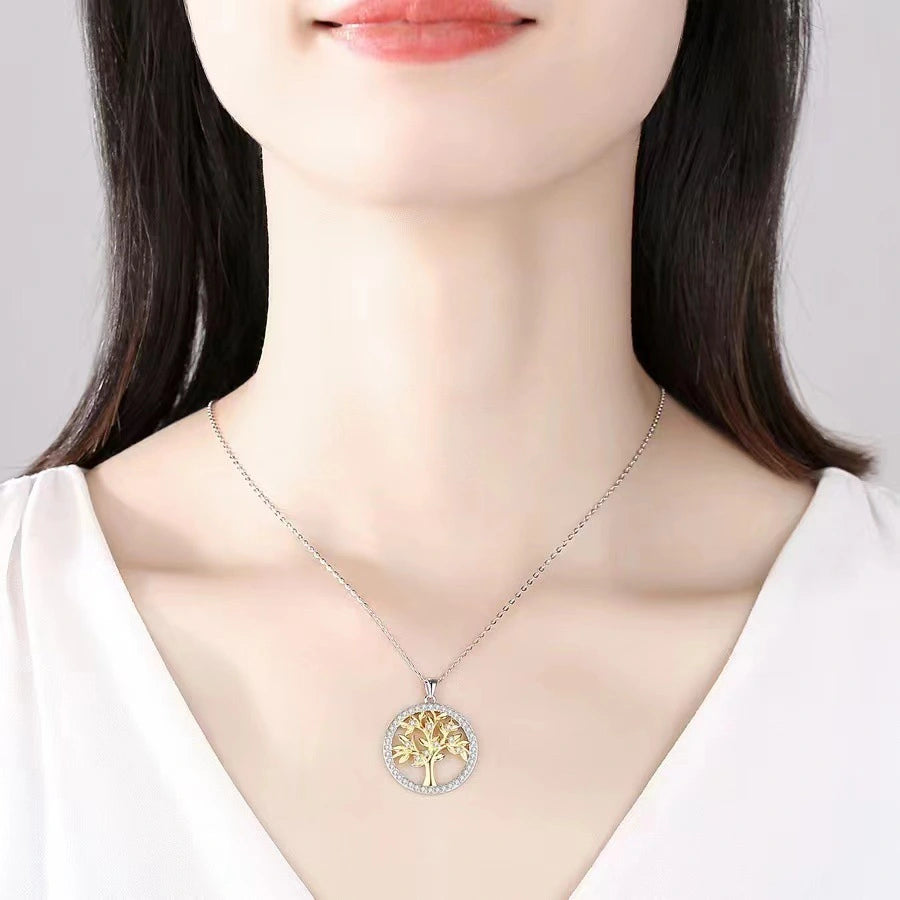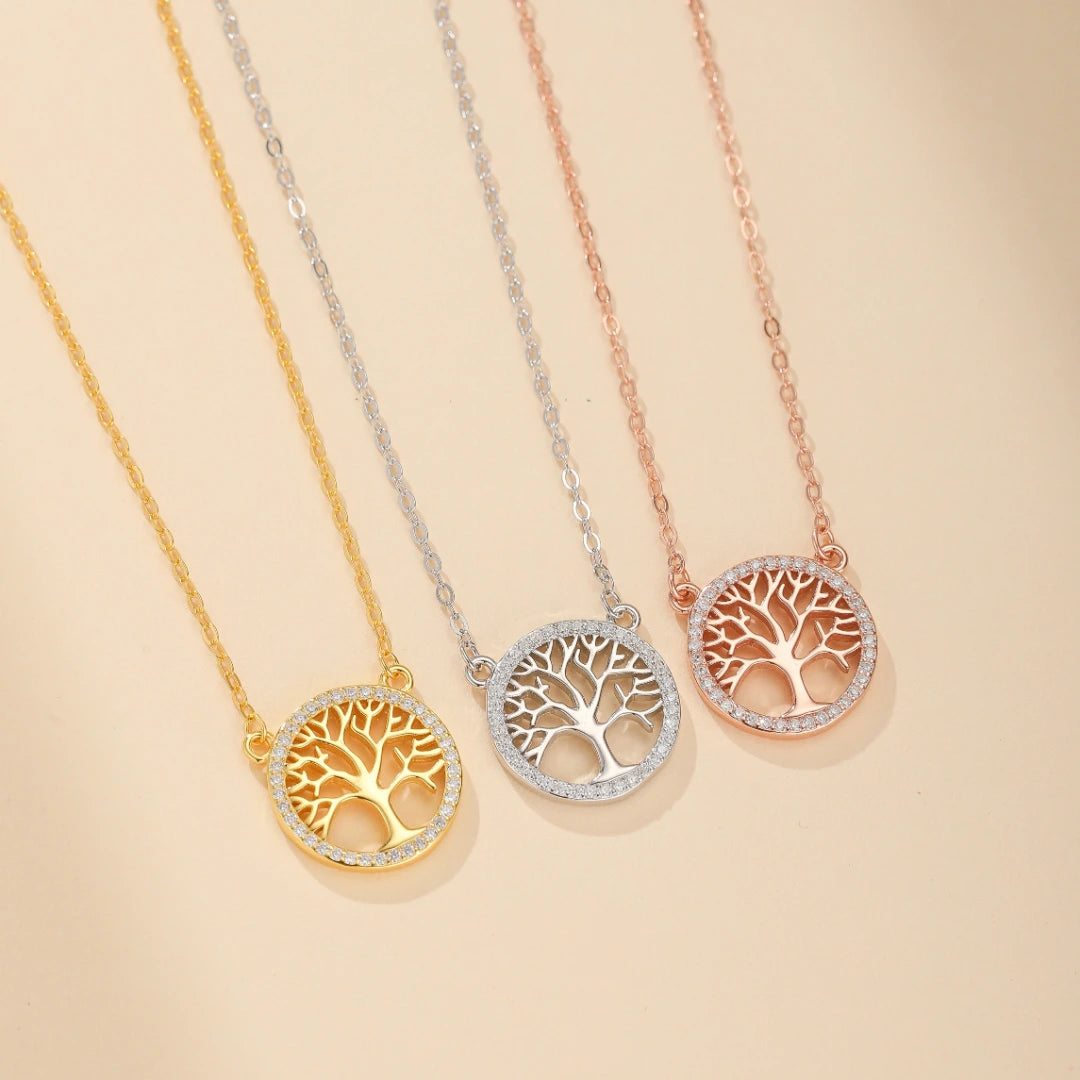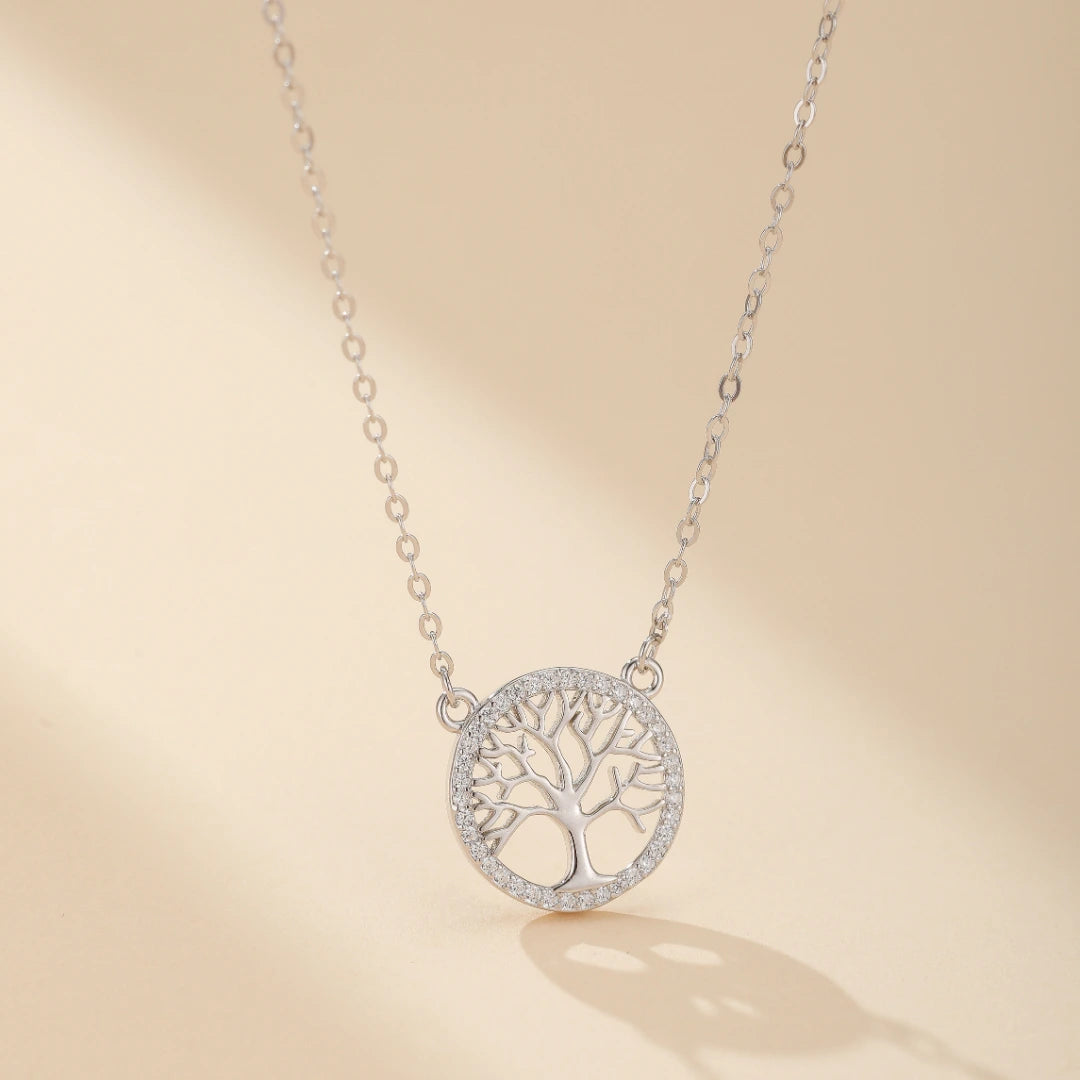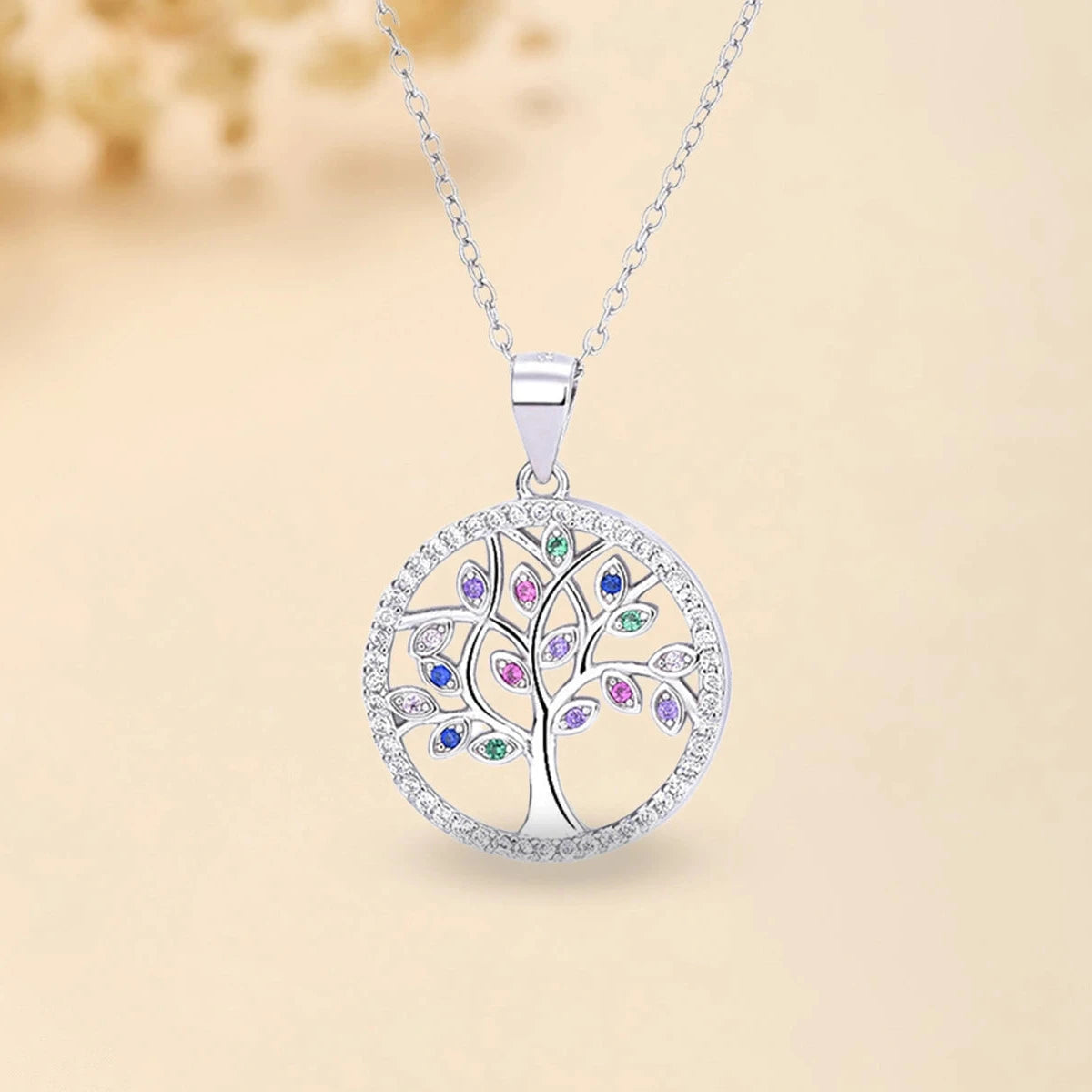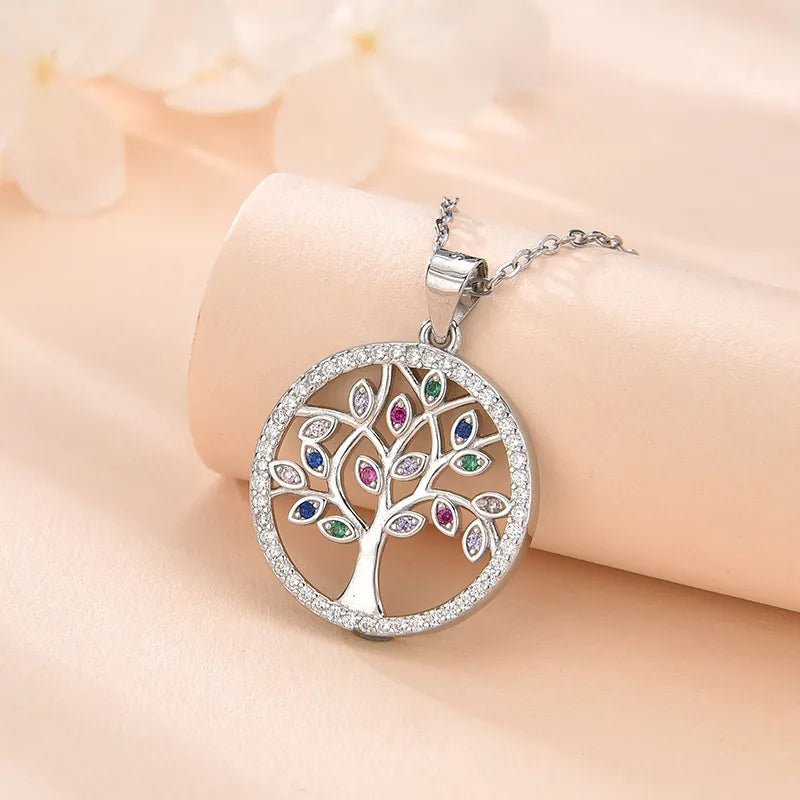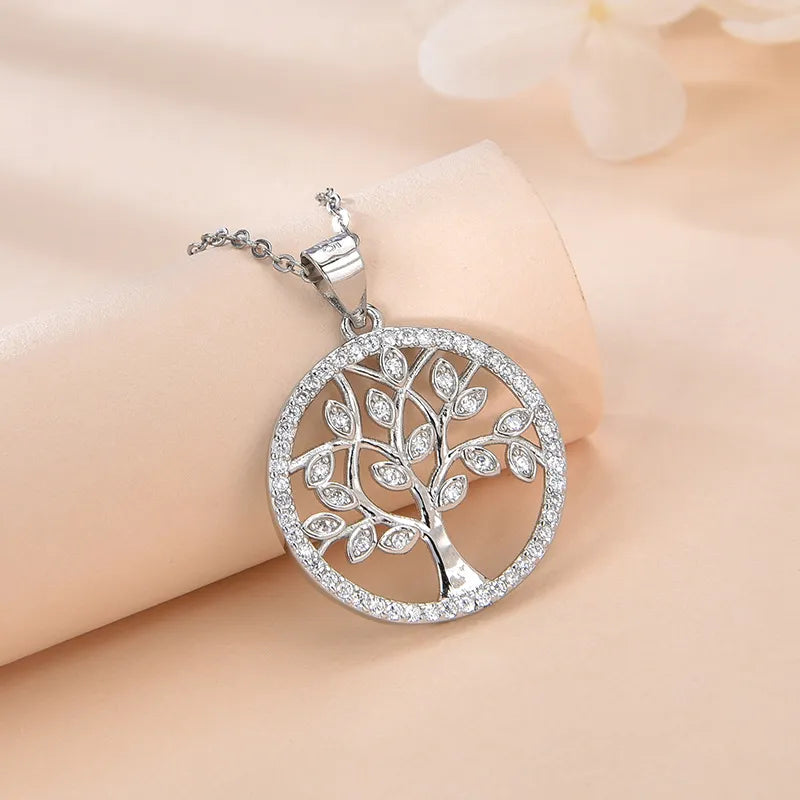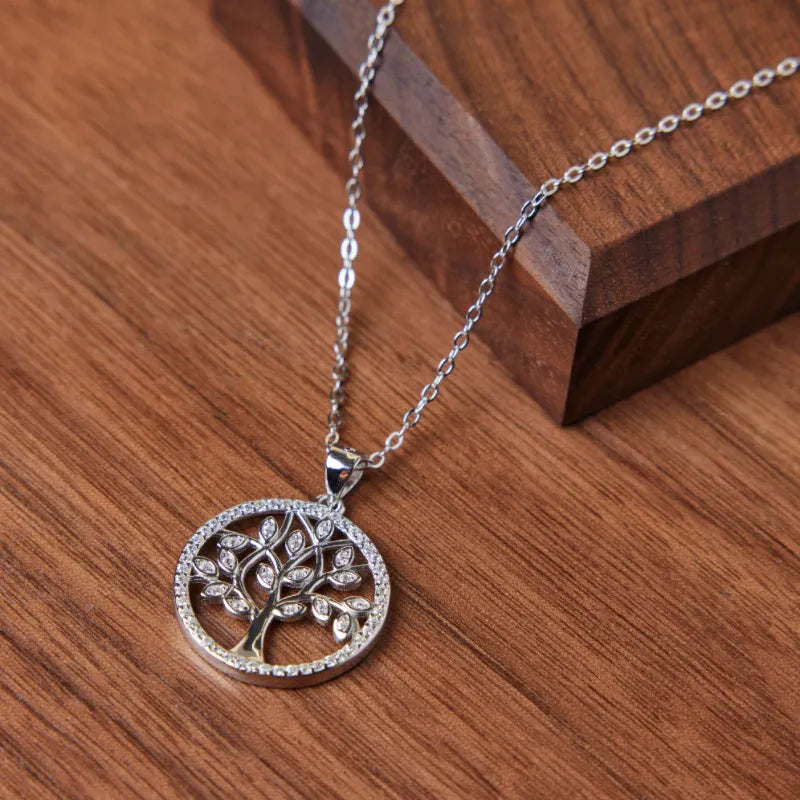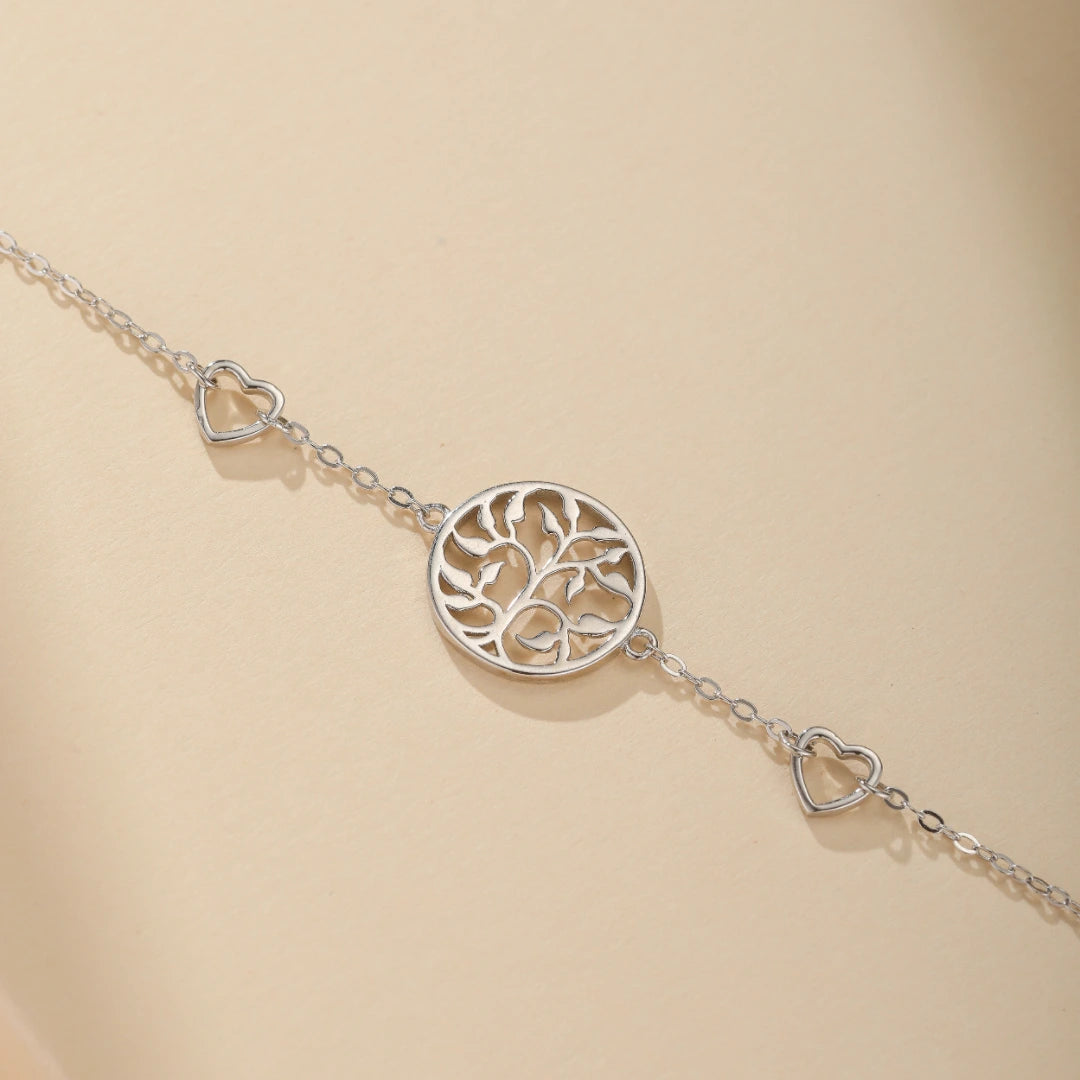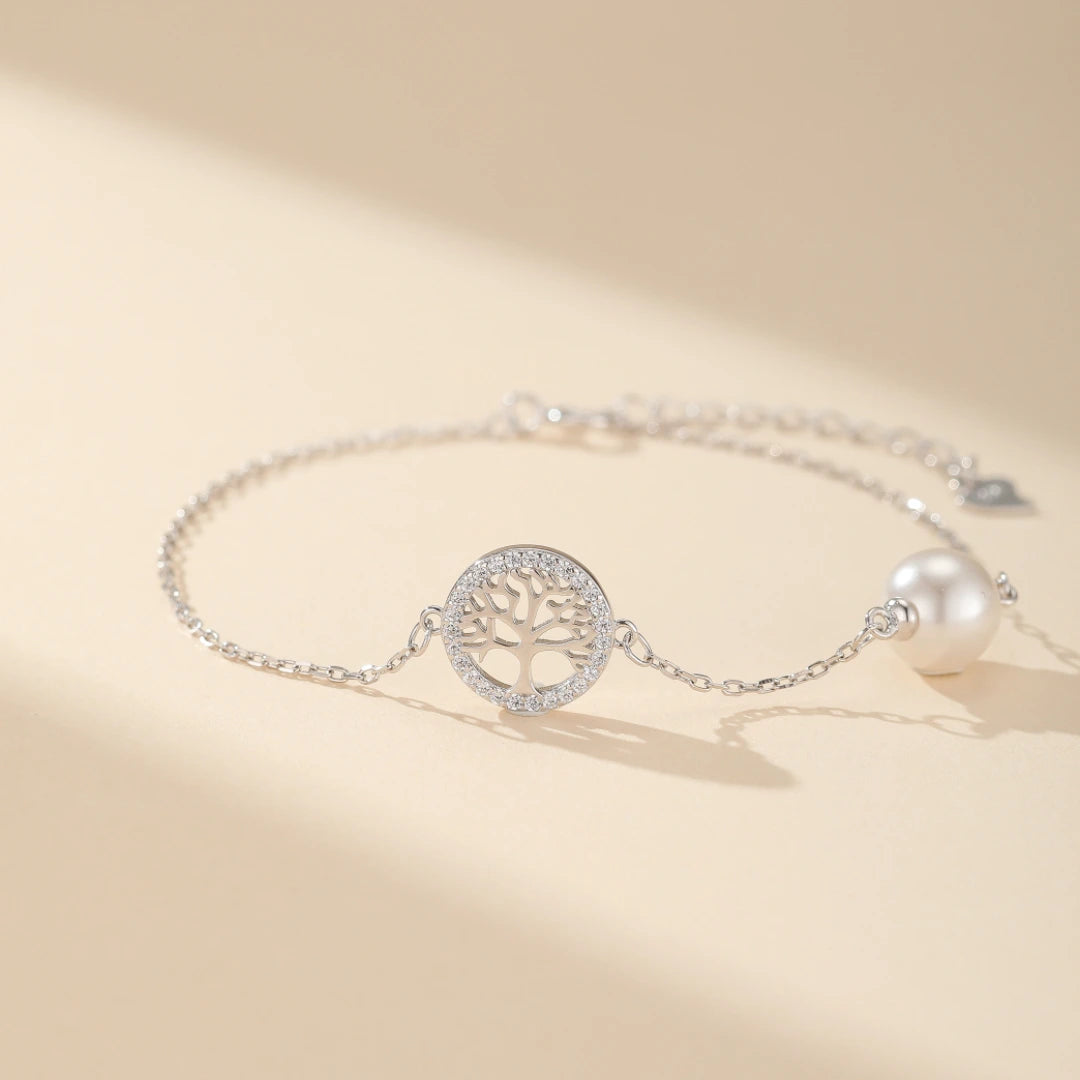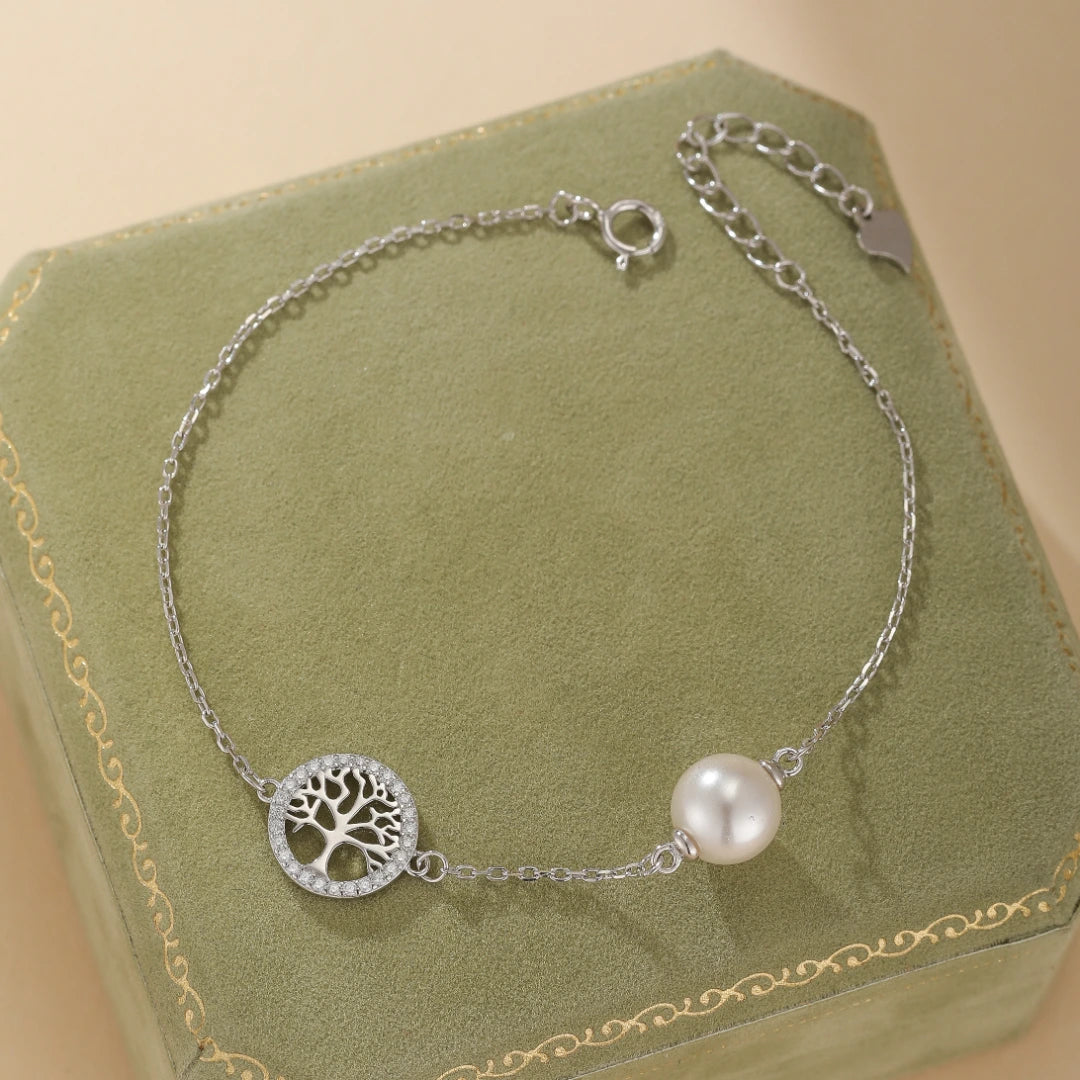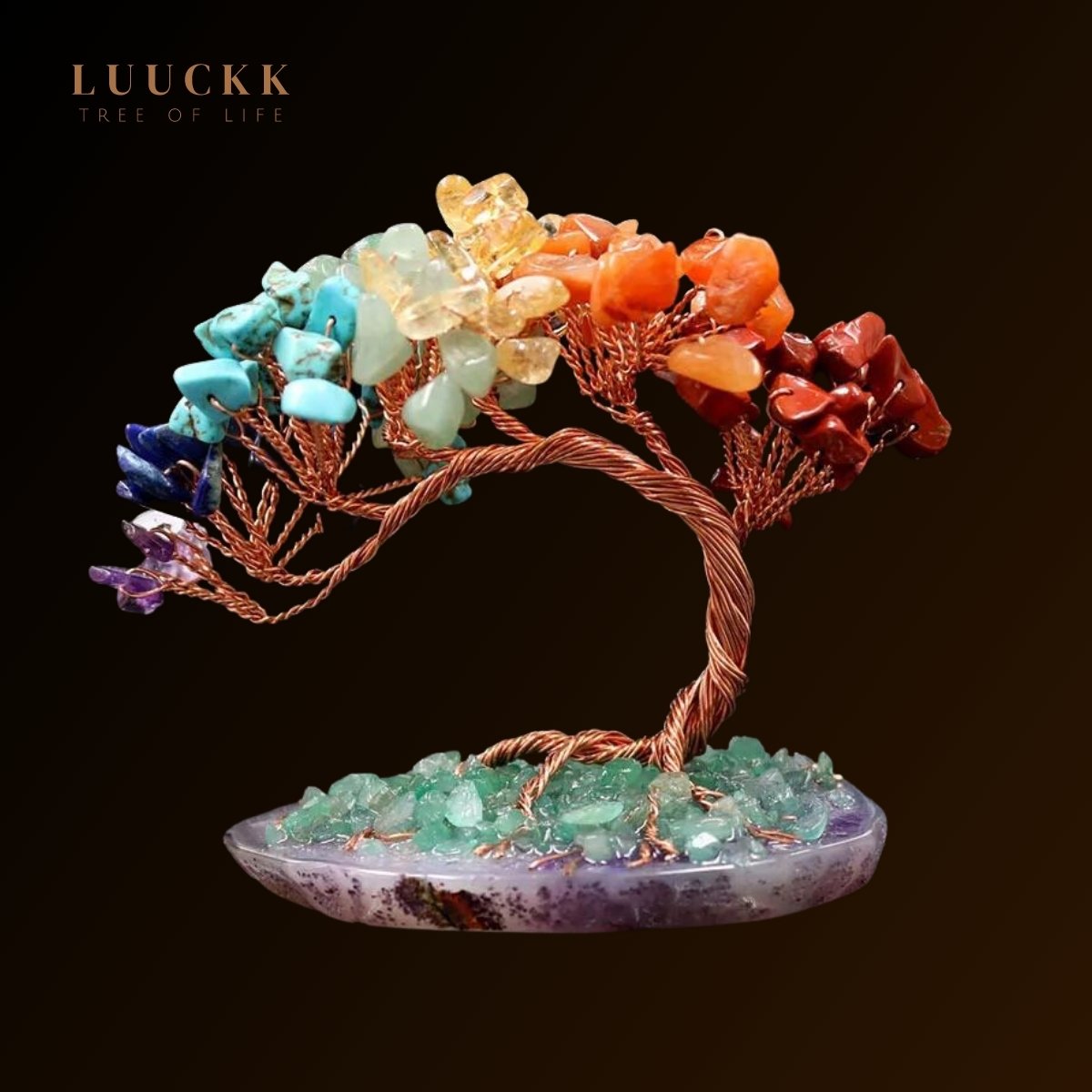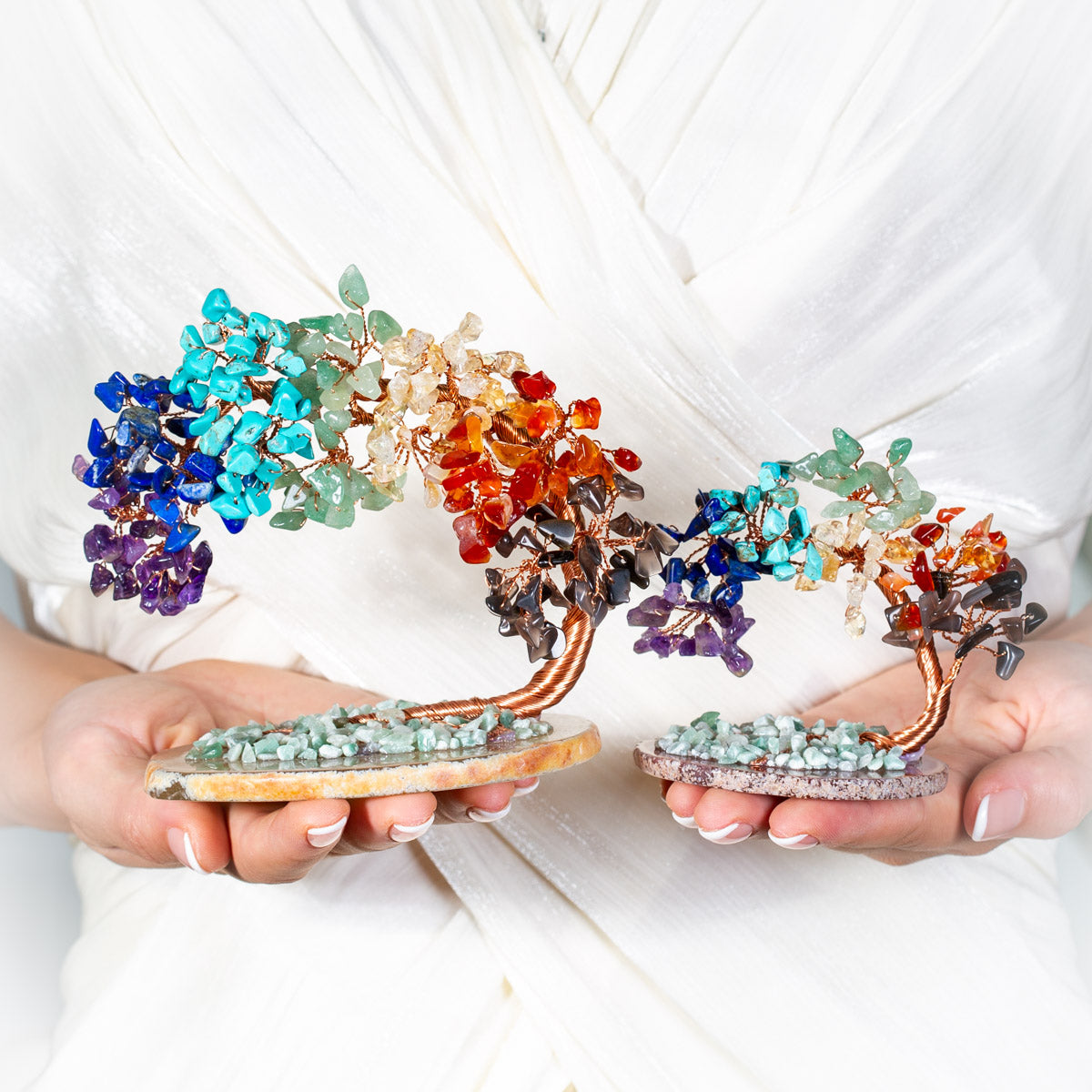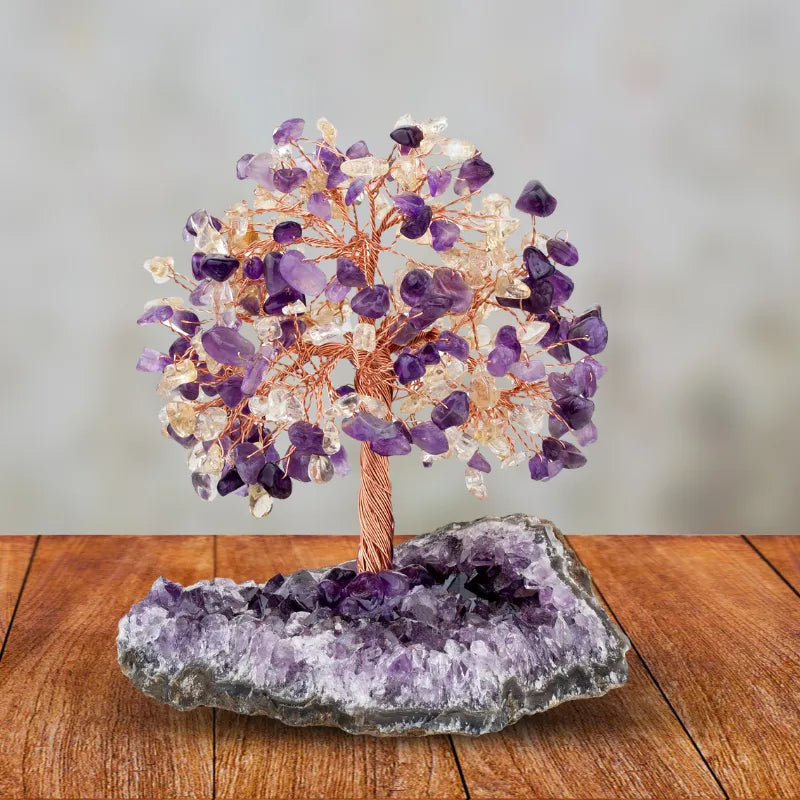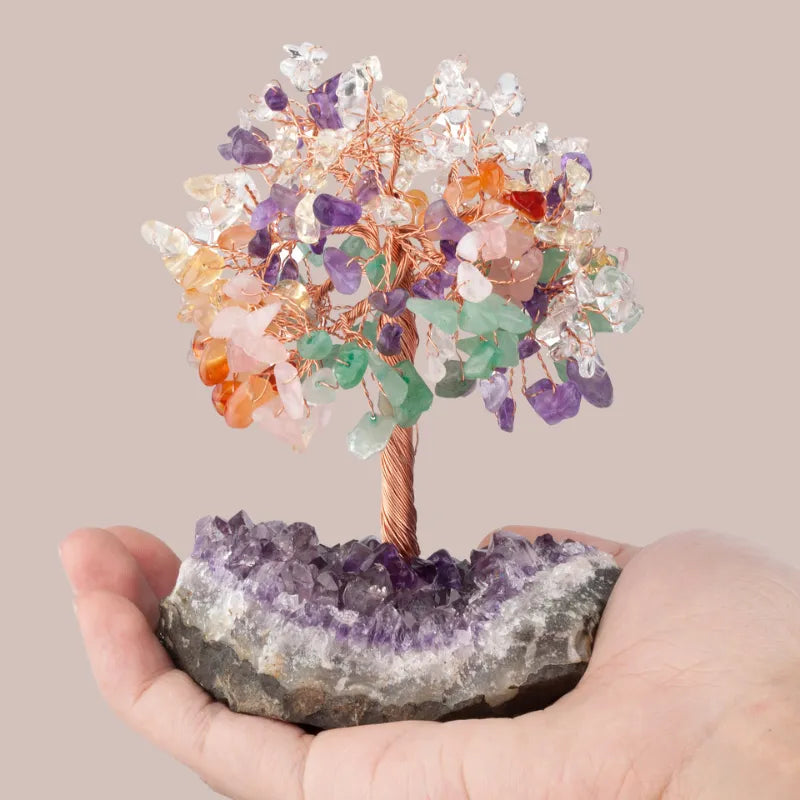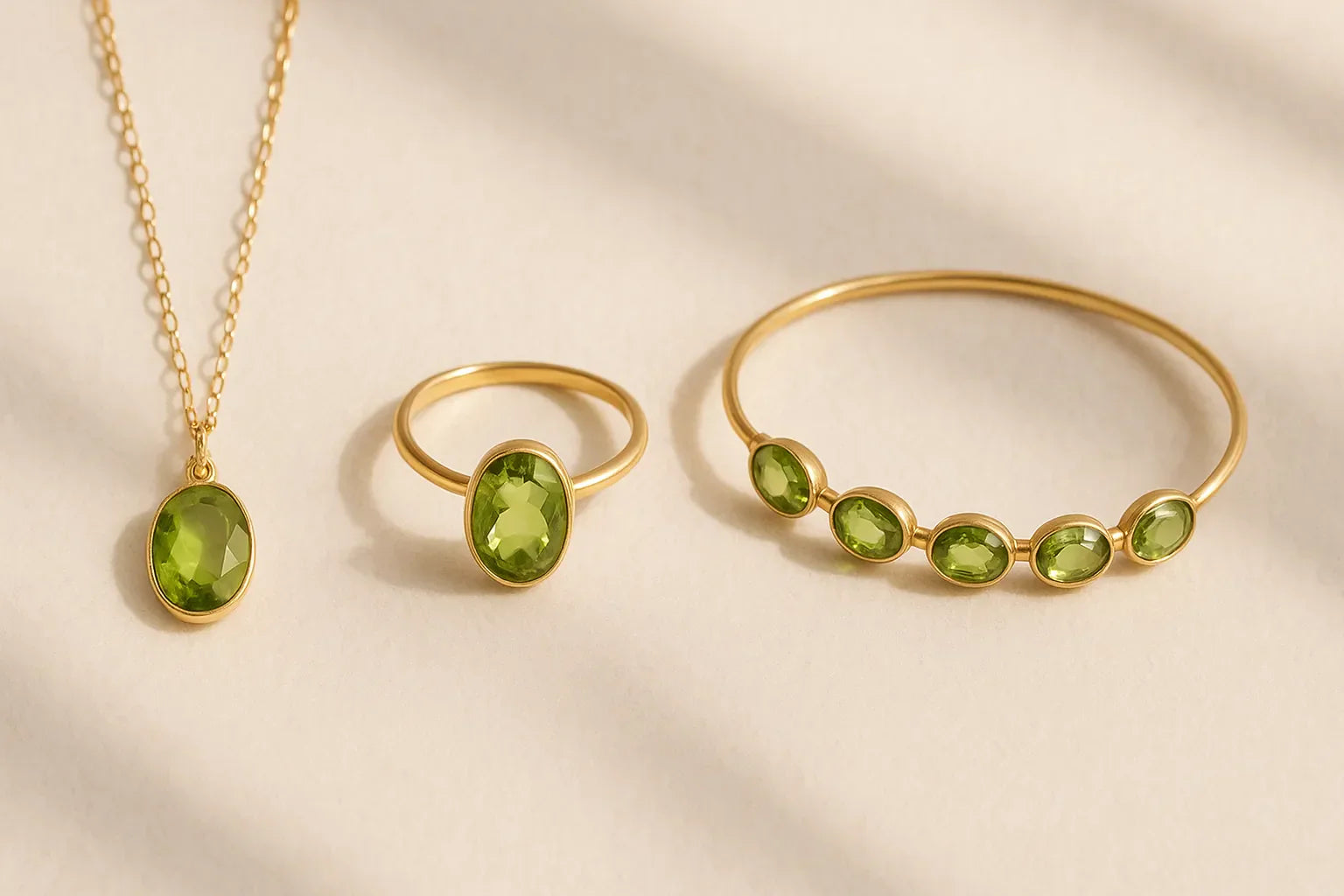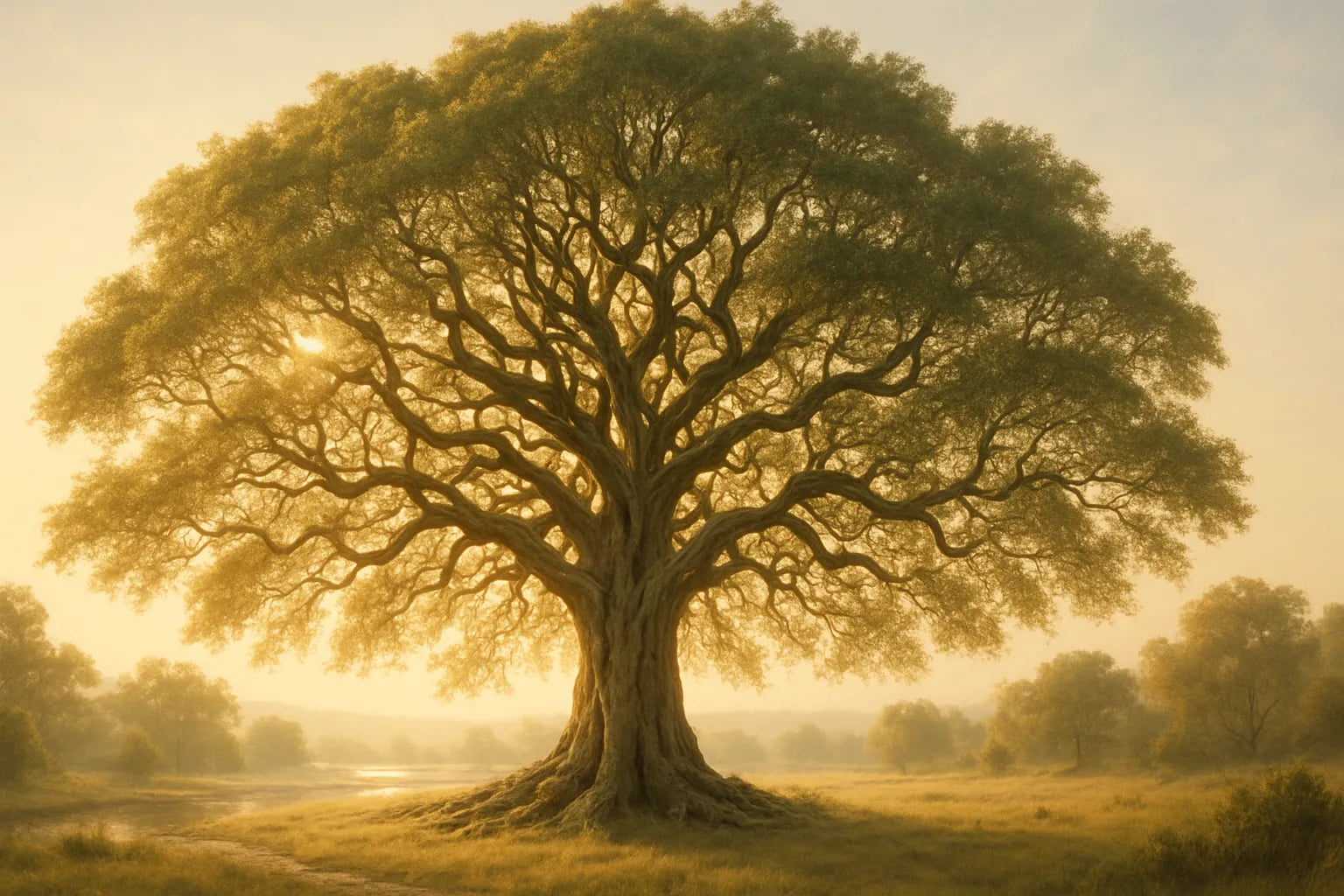The Tree of Life… A symbol we encounter everywhere, whether in a jewelry store, in the heart of a zen interior decoration, or even in personal development books. This motif—so simple in representation, a tree rooted in the earth with branches reaching toward the sky—hides immense symbolic, historical, and spiritual richness.
If you’ve ever wondered where this symbol comes from, what it means, why it’s used in decoration or jewelry, and how to choose it properly according to your needs, this guide is made for you. Because yes, the Tree of Life isn’t limited to a pretty shape; it’s a true bridge between cultures, beliefs, and energies.
This complete guide offers you a deep journey through the origins, symbolism, decorative and spiritual uses, as well as through natural stone jewelry. Get ready to discover much more than a simple motif: a genuine art of living.
The Tree of Life: An Ancient and Universal Symbol
The Tree of Life, as we know it today, is not a modern invention. This loaded symbol is actually an ancestral archetype, present for millennia in most civilizations. And that’s no accident. The tree, as a natural element, has always fascinated humankind. By its structure, its life cycle, its ability to connect earth and sky, it embodies life itself in its deepest essence.
Anthropologically, one can consider the tree as one of humanity’s first symbolic “mirrors.” It represents what humans feel deeply: the need for rootedness, the quest for elevation, the link to origins, and the desire for transcendence. It’s therefore not surprising that virtually every culture has a “sacred tree.”
In ancient civilizations: a cosmic pillar
Among the Sumerians, considered one of the world’s first great civilizations (around 4000 BCE), the Tree of Life is already mentioned in cuneiform tablets. It symbolizes the axis of the world, a bridge between the underworld, earth, and heavens.
In ancient Egypt, the Tree of Life is associated with the goddess Isis, guardian of magic and fertility. It appears in funerary ritual scenes, often as a sacred acacia nourishing the soul of the deceased, thus ensuring its regeneration in the afterlife.
The Hebrews mention the Tree of Life in Genesis: placed at the center of the Garden of Eden, it is opposed to the Tree of Knowledge of good and evil. Here, the Tree of Life becomes the emblem of eternal life, to which humanity loses access after the “fall.”
Among the Celts, a people deeply connected to nature, each tree was revered as a living sacred being. Certain trees, like the oak or yew, were considered portals to other worlds. The Tree of Life, or “Crann Bethadh” in Gaelic, represented the interconnection of all things. It linked spiritual, material, and celestial realms.
In Eastern traditions: awakening and wisdom
Ancient India offers a fascinating version of the sacred tree through the “Kalpavriksha,” the wish-fulfilling tree mentioned in Vedic texts. It is seen as a celestial tree capable of granting the soul’s deepest desires, a symbol of spiritual and material abundance.
But it’s in Buddhism that the tree takes even greater significance. The “Bodhi Tree,” under which Siddhartha Gautama achieved enlightenment, became a universal symbol of wisdom, meditation, and spiritual awakening. This sacred fig is today still a pilgrimage site for millions in Sri Lanka and India.
Taoism speaks of the Tree of Immortality at the world’s center, often associated with dragons and phoenixes, mythical creatures of balance and transformation.
In Norse mythology: Yggdrasil, the World Tree
One cannot discuss the Tree of Life without mentioning Yggdrasil, the immense sacred ash of Norse mythology. This gigantic tree supports the nine worlds, including Midgard (the human realm) and Asgard (the realm of the gods). Its roots plunge into the universe’s depths, while its branches stretch to the sky.
Yggdrasil is a true cosmic pillar, a tree of stability in a constantly changing world. It is both an axis, a refuge, and a place of trials, nourished by three sacred wells representing knowledge, destiny, and ancestral memory.
A constant symbolism across the world
Despite cultural and temporal diversity, the Tree of Life shares the same symbolic thread everywhere: growth, regeneration, and connection between the planes of existence. It also embodies natural cycles—birth, death, rebirth—present in nature and human life.
Through its longevity, the tree becomes a symbol of transmission and memory. It survives generations, preserves memories, and tells history. That’s probably why we instinctively refer to our ancestors as a “family tree.” Language, once again, betrays the power of collective imagination.
Why does the Tree of Life still move us today?
Today, in a fast-paced world where individualism can disconnect us from one another, the Tree of Life symbol is making a comeback. It speaks of rootedness, return to essentials, and connectedness. It reminds us that we are part of a larger whole, that our lives fit into a greater cycle, and that we also need roots to grow.
This symbolic power, both simple and profound, explains the success of the Tree of Life in interiors, jewelry, and meditation. It is not just a decorative or aesthetic object, but an energetic, emotional, and philosophical support.
To explore these aspects further, we invite you to read the article Meaning of the Tree of Life and Benefits, which delves into contemporary and spiritual interpretations of this universal symbol.
A Deep Meaning: Life, Energy, Harmony
If the Tree of Life has endured through the ages, it’s because it answers a universal question each human being asks at some point: What is the meaning of my life, and how can I be rooted while evolving?
Unlike other symbols fixed in a specific religious or cultural context, the Tree of Life is universal, living, and evolving. It imposes nothing but invites reflection, recentering, and connection. It is a total symbol: it speaks of body, soul, spirit, and the link we maintain with the world and others.
A symbol of growth and evolution
The very image of the tree is a powerful metaphor for human development. It springs from a seed, roots itself, grows, strengthens, develops branches, yields leaves and fruit, transmits its energy, and begins anew. Each stage mirrors a phase of human life.
We are all, in a way, trees in progress. We draw from our past (roots), stabilize in our present (trunk), and reach toward the future, the unknown, and others (branches). This deeply human and spiritual symbolism gives the Tree of Life its strength.
Balance between earth and sky
The Tree of Life, by its shape, is a symbol of perfect balance. It connects earth and sky, visible and invisible, matter and spirit. Its roots plunge deep into the soil while its branches reach toward the clouds.
This duality is not conflictual but complementary. The tree teaches us that to rise spiritually, one must first be well rooted. It also reminds us that balance between action (branches) and stability (roots) is key to a harmonious life.
A representation of life’s cycle
The cycle of seasons, births and rebirths, leaves falling in autumn to sprout anew in spring… everything about the tree evokes constant transformation.
In many spiritual traditions, the Tree of Life is associated with the cycle of death and rebirth, loss and regeneration. It teaches that every end contains the seed of a new beginning and that life is movement, not stagnation.
This symbol is often used in therapeutic support during transitions: mourning, separation, career change, moving, pregnancy, etc. It helps to accept changes and give them meaning.
A source of positive energy
In lithotherapy and Feng Shui, the Tree of Life is considered an emitter of positive energies. It stabilizes, harmonizes, and protects. Made with natural stones, its virtues are amplified: each stone adds a specific vibrational dimension.
- Grounding: thanks to its roots, it helps to stay centered, connected to reality and values.
- Protection: it acts as an energetic filter, especially when paired with stones like tiger’s eye or tourmaline.
- Regeneration: it promotes inner healing and a return to emotional balance.
- Spiritual elevation: its branches remind us that personal evolution never stops.
Worn as jewelry or placed in living spaces, the Tree of Life acts as a focal point of harmony. It attracts good vibrations, soothes tensions, and recenters the mind.
An interconnection with the world
Finally, the Tree of Life symbolizes a fundamental truth: we are not alone. Everything about its structure recalls interconnection among living beings.
Its roots intertwine with those of other trees. Its leaves nourish the air. Its trunk houses animals. It is a living ecosystem, an image of natural solidarity. That’s why it is so often used in personal development or self-reflection: it encourages us to recognize our place in the universe and honor our connections to others and nature.
This link can also be familial: the Tree of Life is often used as a family metaphor, conveying generations past and future. It thus becomes a symbolic family tree, bearer of our identity and history.
In summary, the Tree of Life is not just an aesthetic or decorative symbol. It is an inner compass, a symbolic guide inviting us to:
- Stay rooted in our values while growing
- Cultivate balance between inner and outer worlds
- Accept life cycles and transformations
- Connect with others and the world around us
- Find meaning in our personal journey
To learn how this symbol can integrate into your daily life, check out our Complete Guide to Natural Stone Tree of Life: Decoration, Meaning, Selection and Use.

Natural Stones and the Tree of Life: A Spiritual Union
The Tree of Life is a powerful symbol in itself, but when associated with natural stones, it takes on a new dimension. This marriage of two natural elements creates objects that are simultaneously symbolic, aesthetic, and energetic, highly prized in lithotherapy, spiritual decoration, and jewelry.
It’s not simply a matter of style. Natural stones, born deep within the earth, carry a millennia-old mineral memory and specific vibration that resonates with our own energy. Combined with the Tree of Life, they form a living symbolic tool: a meditation aid, a good-luck charm, a personal balance center.
Why combine the Tree of Life with natural stones?
The Tree of Life represents structure, intention, and symbolism. The stones represent frequency, active energy, and concrete action. Pairing the two affects both the unconscious (through the symbol) and the energetic body (through the stones’ properties).
In other words, where the Tree of Life structures meaning, the stones amplify it. This duo becomes a true catalyst for inner transformation.
A Tree of Life adorned with natural stones can thus be used for:
- As a meditation object to set a specific intention
- As an energy tool to purify living spaces
- As personalized jewelry suited to mood, need, or situation
- As a symbolic gift during life’s key transitions (birth, bereavement, career change, marriage…)
How to choose the stones for your Tree of Life?
Each natural stone has its own vibrational properties. Depending on the stones chosen, your Tree of Life will convey a different message and energy. Here is a selection of the most frequently used stones with their symbolic and energetic effects:
- Amethyst: stone of wisdom and spirituality; promotes concentration, meditation, and mental calm. Ideal for a desk, bedroom, or meditation space.
- Rose Quartz: stone of unconditional love; heals emotional wounds, reinforces self-love, and attracts healthy relationships. Perfect in a bedroom or as a gift.
- Tiger’s Eye: protection and self-confidence stone; acts as an energy shield while stimulating willpower. Very useful during periods of change.
- Lapis Lazuli: enhances intuition, communication, and self-expression. Ideal for artists, therapists, or anyone seeking personal alignment.
- Green Aventurine: stone of luck and renewal; brings balance, optimism, and dynamism. Perfect in a transition context.
- Black Tourmaline: powerful grounding and purification stone; protects against negative energies and external influences.
- Citrine: stone of joy, creativity, and abundance; stimulates vital energy and boosts self-esteem.
- There are also Tree of Life creations with the seven chakra stones, each representing an energy center in the human body. These are often used in energy healing to balance and harmonize the entire energetic system.
The Tree of Life in Lithotherapy
In lithotherapy, the Tree of Life can serve as a complementary therapeutic tool. It does not replace medical care, of course, but it can support healing and introspection processes.
Here are some concrete uses:
- Placed in a room, it acts as an energetic anchor, capturing, filtering, or diffusing energies depending on the stones it contains.
- In meditation, it serves as a visual support: one can gaze at the tree and focus on an intention (healing, transformation, release…).
- Worn as jewelry, it becomes a personal talisman, accompanying us throughout the day as a reminder of our goals or inner peace.
The combination with stones also allows for customization. Each creation becomes unique, adapted to a person, an emotion, or a specific need.
Aesthetic and Symbolic: An Object That Makes Sense
Besides its energetic effect, the natural stone Tree of Life also seduces by its beauty. There is a wide variety of models:
- Wire trees with tumbled or raw stones
- Wall or tabletop sculptures
- Silver or steel pendants adorned with semi-precious stones
- Trees on wooden stands, quartz, amethyst geode, or selenite
Each model can be crafted by hand in an ethical and spiritual approach. You can even order a bespoke tree based on your birth date, zodiac sign, or dominant chakras.
Some people even collect Trees of Life according to seasons, monthly intentions, or moon cycles.
The article Guide to Lithotherapy with Tree of Life will give you keys to associate stones according to your emotional and spiritual needs.
The Decorative Power of the Tree of Life
In a world where we increasingly strive to create soothing, personalized, and meaningful living spaces, the Tree of Life proves to be much more than a simple decorative object. Its presence in a room is not only a matter of aesthetic taste but responds to a deep need for harmony, re-centering, and connection.
Today, Tree of Life motifs appear in metal or wood wall art, as sculptures, as dreamcatchers bearing this symbol, or canvases painting this sacred motif. This is not a passing trend but an expression of an inner quest that invites itself into our daily environment.
A symbol that transforms space
The Tree of Life acts like an energetic pivot in a room. It draws the eye, creates a visual anchor, but above all, it transmits a vibration. As a symbol of balance and vitality, it infuses a dynamic of growth and peace.
Unlike purely aesthetic decor objects, the Tree of Life invites contemplation and introspection. It speaks to the unconscious, awakens something deeper than a simple “wow” effect. It becomes a presence support in an often hectic world.
Where to place the Tree of Life at home?
The positioning of the Tree of Life is not trivial. Depending on the room and use, its presence can support very different intentions. Here are some suggestions inspired by Feng Shui and spatial symbolism:
- At the entrance: a Tree of Life placed at the home’s entrance acts as an energetic guardian. It stabilizes the ambiance as soon as one enters and fosters a sense of welcome, safety, and peace.
- In the living room: it symbolizes family connection, unity, intergenerational transmission, and dialogue. It fits easily above a sofa or as a centerpiece on a main wall.
- In a bedroom: it takes on a more emotional and affectionate dimension. It promotes love, rest, and reconciliation with oneself. Choose one with soft hues or adorned with soothing stones like rose quartz or selenite.
- In a workspace or reading nook: it enhances concentration, mental clarity, and creativity—precious qualities for intellectual or artistic activities.
- In a meditation or spiritual corner: it becomes a sacred focal point conducive to contemplation, energetic re-centering, and chakra alignment. A Tree of Life composed of natural stones is particularly suitable here.

Which material to choose for your decorative Tree of Life?
The choice of material influences both the visual atmosphere and the energy diffused. Each material carries its own vibration:
- Natural wood: for a warm, authentic, and grounded ambiance. Wood is alive and creates a strong link with nature.
- Metal (wrought iron, brass, copper): for a more contemporary, elegant, and structured decoration. Metal reinforces solidity and brings light.
- Natural stones: to combine aesthetics and energetic vibration. Each stone brings a particular quality to the room.
- Textile, macramé, dreamcatcher: perfect for a bohemian and light touch while preserving spiritual symbolism.
There are also illuminated Trees of Life with integrated LEDs, creating a soft and warm ambiance at night—particularly appreciated in bedrooms or relaxation areas.
Creating a sacred space with a Tree of Life
More and more people feel the need to create at home a space dedicated to calm, spirituality, or simply introspection. The Tree of Life then becomes the symbolic heart of this space, around which other elements are arranged: natural stones, incense, candles, meditation mats, intention journals…
It becomes a sanctuary within the home, where one can reconnect with oneself, breathe, and set aside thoughts. In this context, the tree is no longer merely decorative: it becomes a spiritual ally in daily life.
In our article Interior Decoration with the Tree of Life: Harmony and Spirituality in Your Home, we offer concrete ideas to integrate the Tree of Life according to different styles (bohemian, zen, modern, ethnic) and your energetic goals.
Giving a Tree of Life: A Meaningful Gift
In a world saturated with impersonal objects and quickly forgotten gifts, offering a Tree of Life makes a difference. It’s a gesture that touches, speaks, and lasts. Because when you give one, you’re not just offering a decorative object or an elegant piece of jewelry, but a living symbol bearer of intentions, wishes, and values.
The Tree of Life is not merely pleasing to the eye; it conveys meaning. It’s a silent message to a loved one: “I see you, I recognize your journey, I send you grounding, strength, love, and protection.”
This type of gift adapts to a multitude of occasions because it speaks to all ages and all stages of life.
An ideal symbol for life’s major milestones
Giving a Tree of Life is especially meaningful during transitional or renewal moments. It then becomes a symbolic talisman, a marker for the recipient.
- Birth or baptism: to symbolize growth, family roots, and protection. It can be given as a nursery decoration or as personalized jewelry with the child’s birthstone.
- Birthday: to celebrate life, accumulated experiences, and to transmit renewal energy. A Tree of Life necklace with stones matching the recipient’s qualities is particularly appreciated.
- Housewarming: a wall or tabletop Tree of Life harmonizes the space’s energy and sets intentions of peace and prosperity for the inhabitants.
- Wedding or union: the Tree of Life symbolizes unity, growing together, shared roots, and branches opening to the world. A beautiful emblem of commitment.
- Retirement, career change, or reconversion: gifting a Tree of Life in this context conveys: “Here’s to a new chapter; may you be strong, inspired, and guided.”
- Mourning or difficult times: sometimes, the Tree of Life can support through hardship. It becomes a symbol of consolation, transformation, and light at the end of the tunnel.
What’s beautiful about the Tree of Life is that it needs no lengthy explanation. It is immediately understood and felt intuitively.
Which type of Tree of Life should you give?
It all depends on your relationship with the recipient and the occasion. Here, intention outweighs material value.
- Natural stone Tree of Life (wall or tabletop): ideal for new beginnings, moves, or as an anchor in an office or meditation corner.
- Tree of Life necklace: very personal, can be given to a friend, loved one, or partner. Worn close to the heart, it becomes a daily reminder of shared values. Some include semi-precious stones matching the recipient’s emotions or traits.
- Tree of Life bracelet: more discreet, accompanies the everyday with subtlety. Perfect for teenagers, colleagues, or as a small protective talisman.
- Personalized Tree: some models allow adding a date, name, birthstone, or even an engraved intention. An ideal option for truly unique gifts.
To get an overview of possibilities, check out The Natural Stone Tree of Life: The Perfect Gift for Every Occasion for many inspiring ideas.
Giving a Tree of Life is not just about pleasure; it’s about offering a symbol to embody, a vibration to integrate, a story to keep alive.

An intergenerational gift
Finally, the Tree of Life has the precious quality of being cross-generational. It can be given to a child, a parent, a grandparent, or a young couple. It speaks to all ages and generations, because it speaks of life at its most fundamental: growth, connections, love, and resilience.
It’s no surprise it’s increasingly chosen to celebrate family bonds. Some Trees of Life are even designed as symbolic family trees, integrating multiple names and birthstones—a magnificent way to honor a lineage.
Tree of Life Jewelry: An Energetic and Elegant Accessory
Wearing jewelry is often much more than ornamentation. It’s affirming a part of oneself, showcasing a style, and sometimes marking a memory or intention. Among symbolic jewelry, the Tree of Life holds a unique place.
At the crossroads of aesthetics, spirituality, and well-being, Tree of Life jewelry appeals to more and more people. It combines timeless elegance with the power of a millennia-old symbol, often enriched by the vibrational force of natural stones. In short, these pieces are beautiful, meaningful… and highly personal.
A piece with multiple functions
Tree of Life jewelry is versatile. It can be:
- A personal talisman, to remind us daily of an intention, a value, or a spiritual goal.
- An energetic piece, when its materials include natural stones tied to emotions or chakras.
- A memento jewelry, gifted by a loved one or linked to a significant life event.
- An identity jewelry, expressing a life philosophy based on balance, personal growth, and connection with nature.
Unlike purely decorative accessories, Tree of Life jewelry is chosen, worn, and sometimes passed on with strong emotional significance.
To learn how to choose and wear Tree of Life jewelry, see All About Tree of Life Jewelry: Meaning, Choice, and Use.
The Tree of Life Pendant: Symbol Close to the Heart
The Tree of Life pendant is undoubtedly the most emblematic. Worn near the heart, it enhances its symbolic and energetic impact. The trunk at the center of the pendant is often highlighted by a circular design evoking life’s cycle, perfection, and unity.
This type of pendant is often chosen to:
- Reconnect with oneself daily
- Cultivate inner peace, especially when paired with stones like rose quartz or amethyst
- Feel protected and aligned during transitions
There is a wide variety of models, from minimalist silver or stainless steel styles to artisanal versions with natural stones embedded in the branches.
Some models even allow full customization: engraving a name, selecting stones according to chakras, combining with a mantra. These become true intention jewelry.
For details, visit: Tree of Life Necklace: Why Choose This Timeless Jewelry? The Complete Guide
The Tree of Life Bracelet: Discreet Protection
The Tree of Life bracelet, more discreet, is worn on the wrist and becomes a daily companion. Often made of natural stone beads, it can be chosen based on:
- Desired vibrational properties (calm, grounding, vitality…)
- Preferred colors
- Chakra to balance
The tree pendant is generally integrated at the center or as a charm, serving as a symbolic anchor.
This jewelry is often given in contexts of support or friendship: it silently says “I’m thinking of you,” “you are protected,” “I’m with you.” It’s also very popular with teenagers for being both symbolic and modern.
Learn more: Tree of Life Bracelet: All You Need to Know
Other variations: a symbol that adapts to all
Beyond necklaces and bracelets, the Tree of Life appears in:
- Earrings, for a subtler touch, often associated with self-expression and femininity
- Rings, sometimes open or adorned with small stones, ideal for anchoring a specific intention
- Bag charms or keychains, used as protective talismans always kept close
- Charms for customizable bracelets, to combine with other symbols or stones
There are also coordinated sets (necklace + bracelet + earrings) highly appreciated as gifts, especially for birthdays, anniversaries, or Mother’s Day.
When and why to gift Tree of Life jewelry?
Tree of Life jewelry marks special life phases. For example:
- Milestone birthdays (30, 40, 50…) – symbolizes the journey and upcoming stages
- Personal or professional transitions – accompanied by support and protection
- After a trial – becomes an object of reconstruction and reminder of inner strength
- Festive occasions – birth, baptism, graduation, personal achievements…
The Tree of Life thus becomes a memory talisman that can be worn long-term, a gentle and meaningful companion.
How to choose your Tree of Life jewelry?
Essential criteria:
- Material: choose silver, stainless steel, or hypoallergenic metals for durability and comfort
- Stones: select based on their energy (amethyst for calm, citrine for abundance, labradorite for protection…)
- Shape: classic circle for unity, stylized tree for creativity, engraved for minimalism…
- Intention: pick jewelry that resonates with a precise need (grounding, confidence, self-love…)
Conclusion
The Tree of Life is not a trend. It is a universal archetype deeply embedded in our collective unconscious. It speaks to everyone, regardless of beliefs or life paths.
Whether in a home, around the neck, or in a meditation space, it acts as a daily reminder of who we are: beings in perpetual growth, connected to earth and sky, to others and to ourselves.
If you are seeking an object that combines aesthetics, profound meaning, and positive energy, the Tree of Life will undoubtedly find a place in your life.
Want to discover our handcrafted and personalized Tree of Life creations? Visit our shop to choose the tree that reflects you.
Our Tree of Life Articles
- All About Tree of Life Jewelry: Meaning, Choice, and Use
- Complete Guide to Natural Stone Tree of Life: Decoration, Meaning, Selection and Use
- Guide to Lithotherapy with Tree of Life
- Interior Decoration with the Tree of Life: Harmony and Spirituality in Your Home
- The Natural Stone Tree of Life: The Perfect Gift for Every Occasion
- All About Tree of Life Jewelry: Meaning, Choice, and Use
- Tree of Life Necklace: Why Choose This Timeless Jewelry? The Complete Guide
- Tree of Life Bracelet: All You Need to Know
FAQ – Everything to Know About the Tree of Life
- What does the Tree of Life symbolize? The Tree of Life symbolizes balance, growth, inner strength, connection between earth and sky, and interconnection among all living beings.
- What is the origin of the Tree of Life? It appears in many ancient cultures: Celts, Egyptians, Buddhists, Norse… Each civilization attributes sacred qualities to it.
- Why wear Tree of Life jewelry? To reconnect with oneself, symbolize a personal intention, or benefit from the protective and balancing energy of the symbol.
- Which Tree of Life to gift? A jewelry piece for a personal gift, or a decorative Tree of Life (wall or tabletop) to celebrate a new beginning, birth, or housewarming.
- Which natural stones to pair with the Tree of Life? It depends on the intention: amethyst for calm, rose quartz for love, tiger’s eye for protection, citrine for joy, etc.
- Where to place the Tree of Life at home? In the entrance to welcome energy, in the living room for family harmony, or in a meditation corner for inner peace.
- Does the Tree of Life have an energetic function? Yes. It can act as an anchor, protector, or harmonizer of energies, especially when combined with natural stones.
- What’s the difference between a decorative and jewelry Tree of Life? The decorative object influences atmosphere, while jewelry accompanies the person in daily life. Both transmit complementary energies.
- Can the Tree of Life be personalized? Yes, certain models allow adding specific stones, names, dates, or personal engravings.
- Is the Tree of Life tied to any religion? No. It is a universal symbol used in various spiritual traditions, without exclusive religious affiliation.
